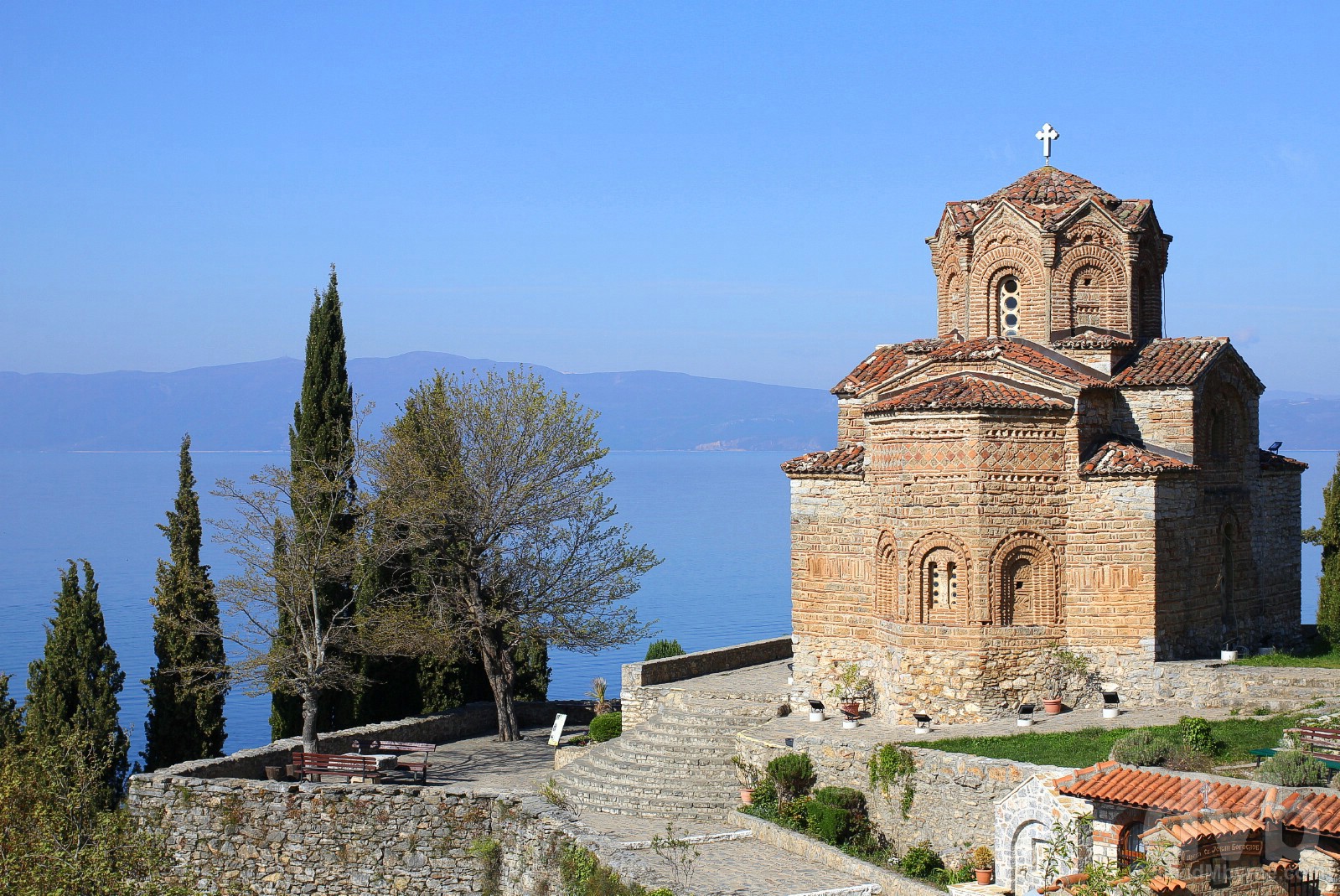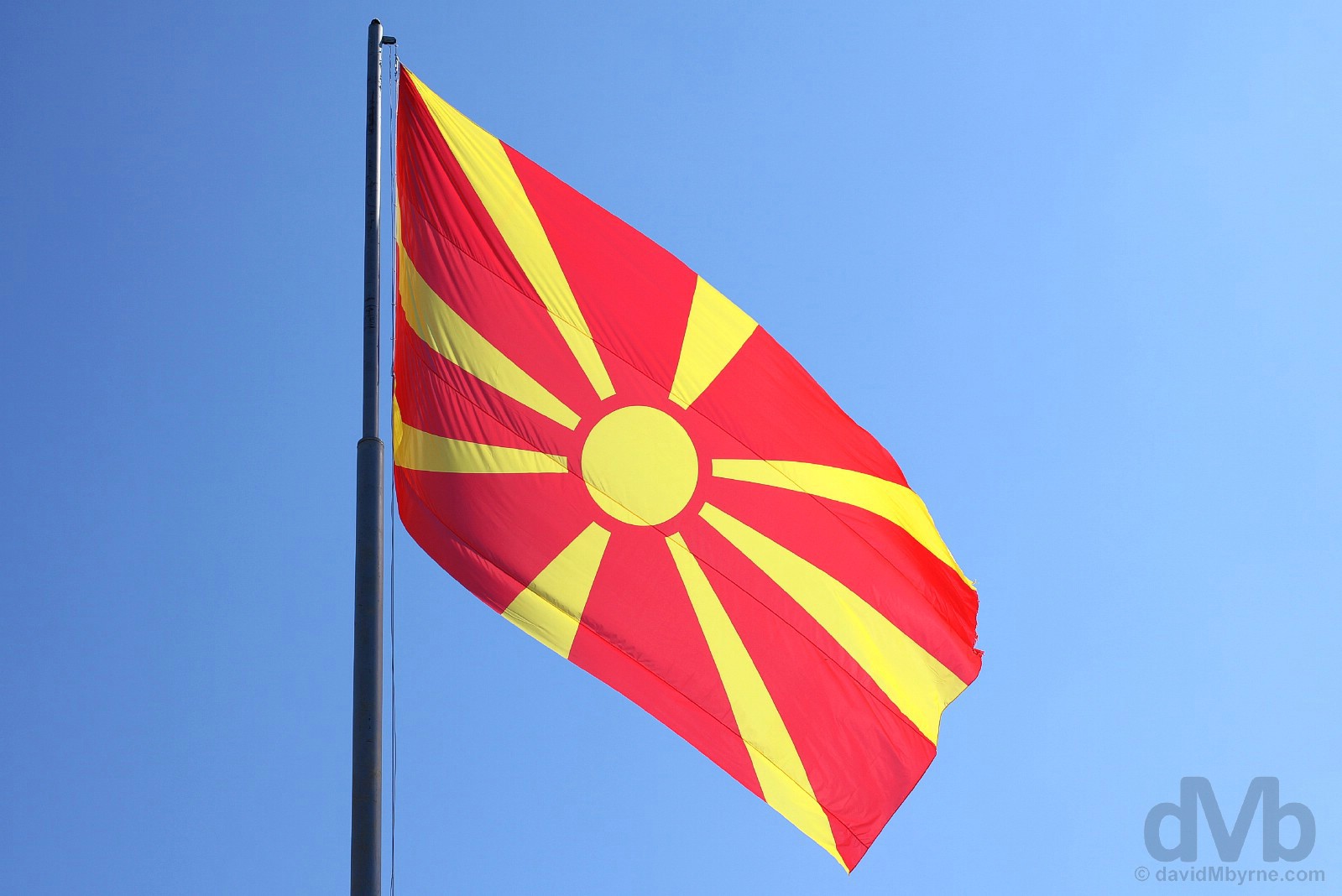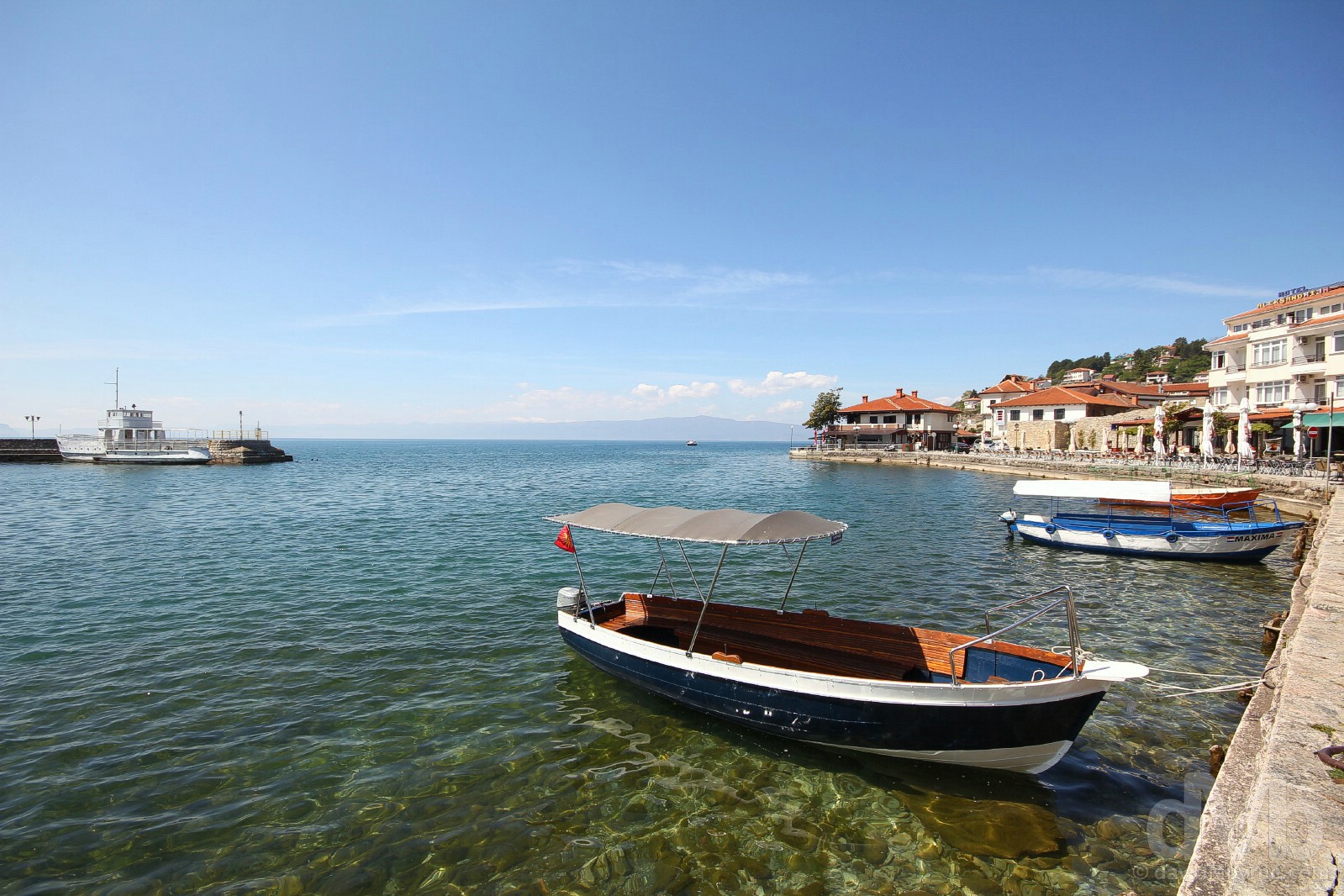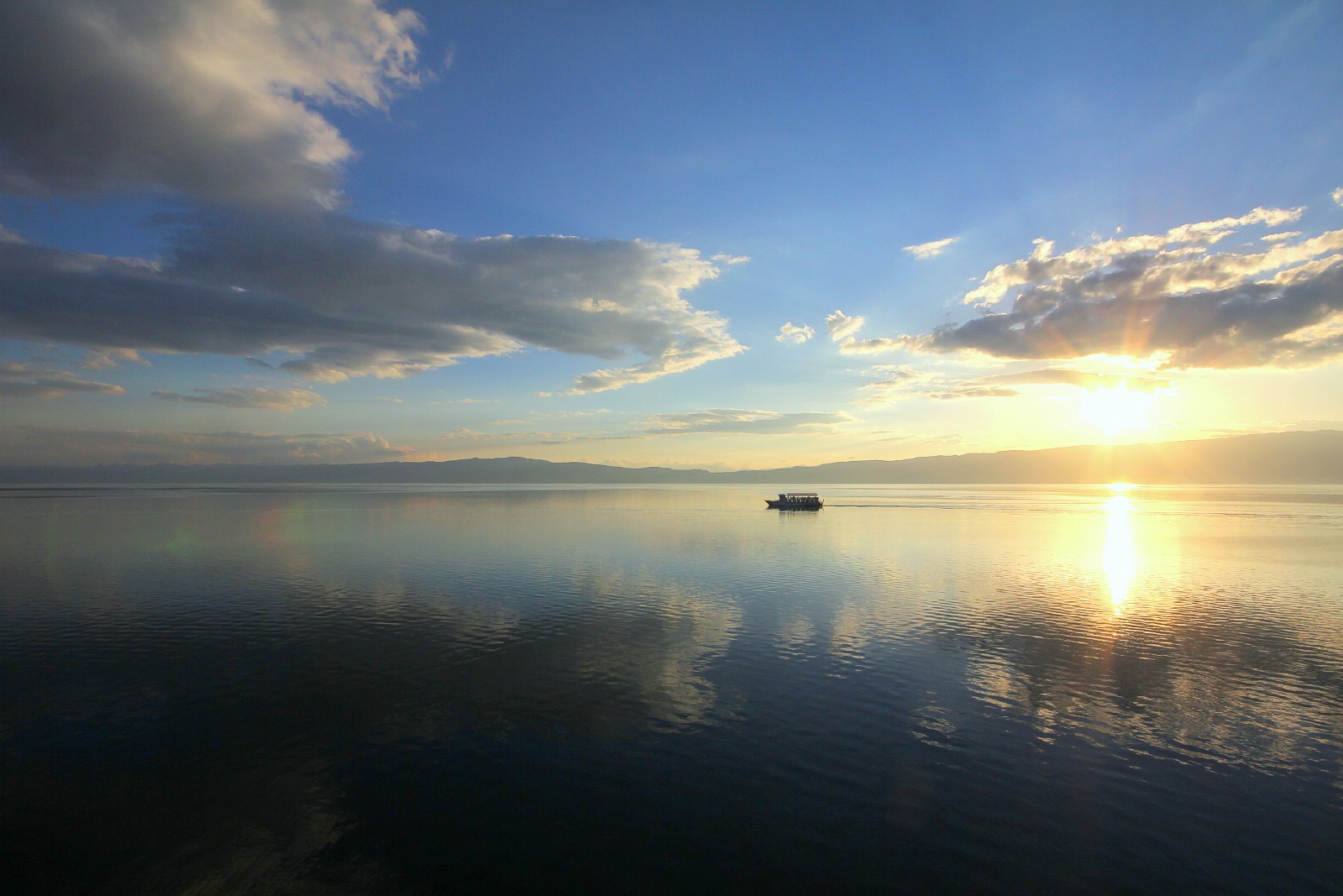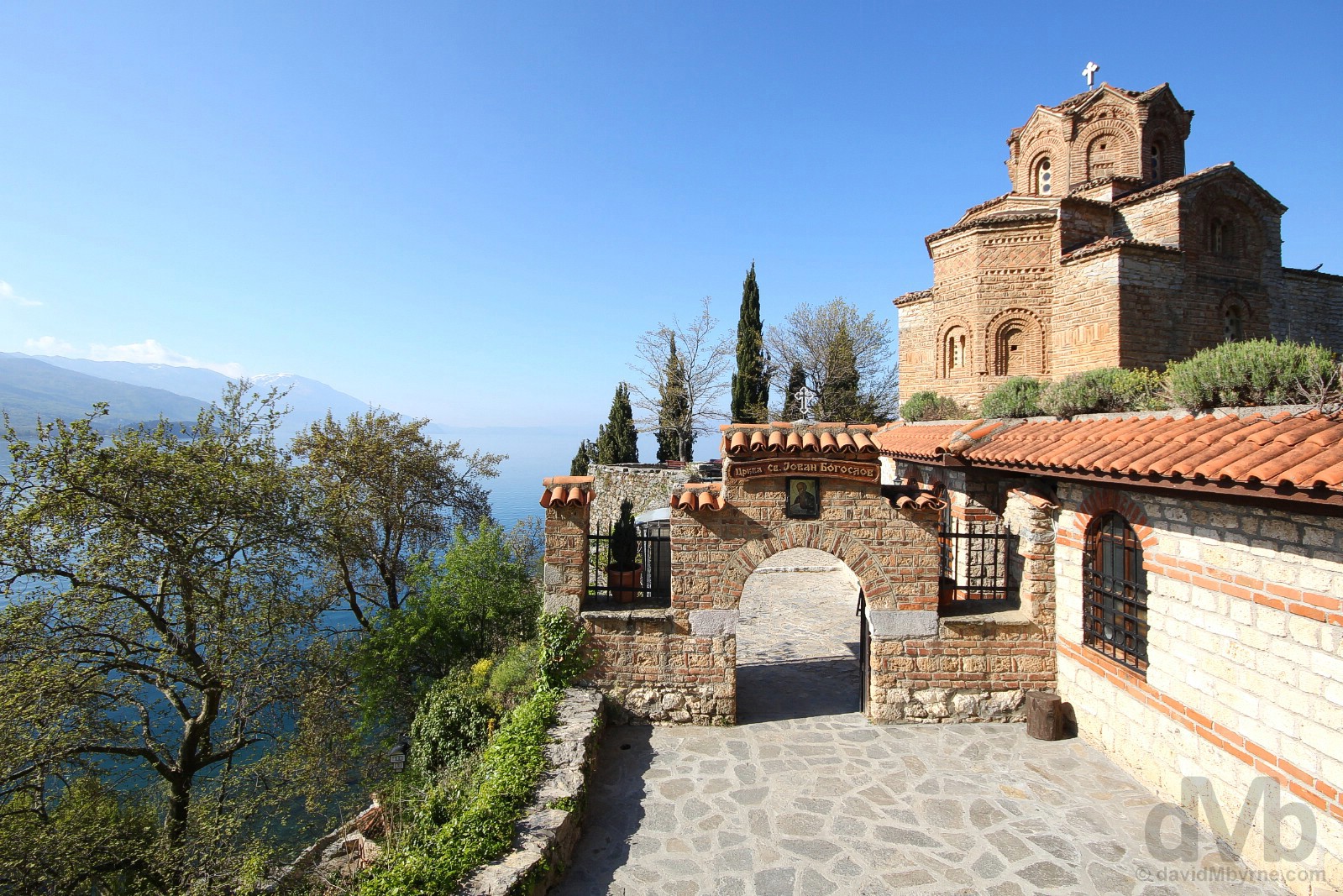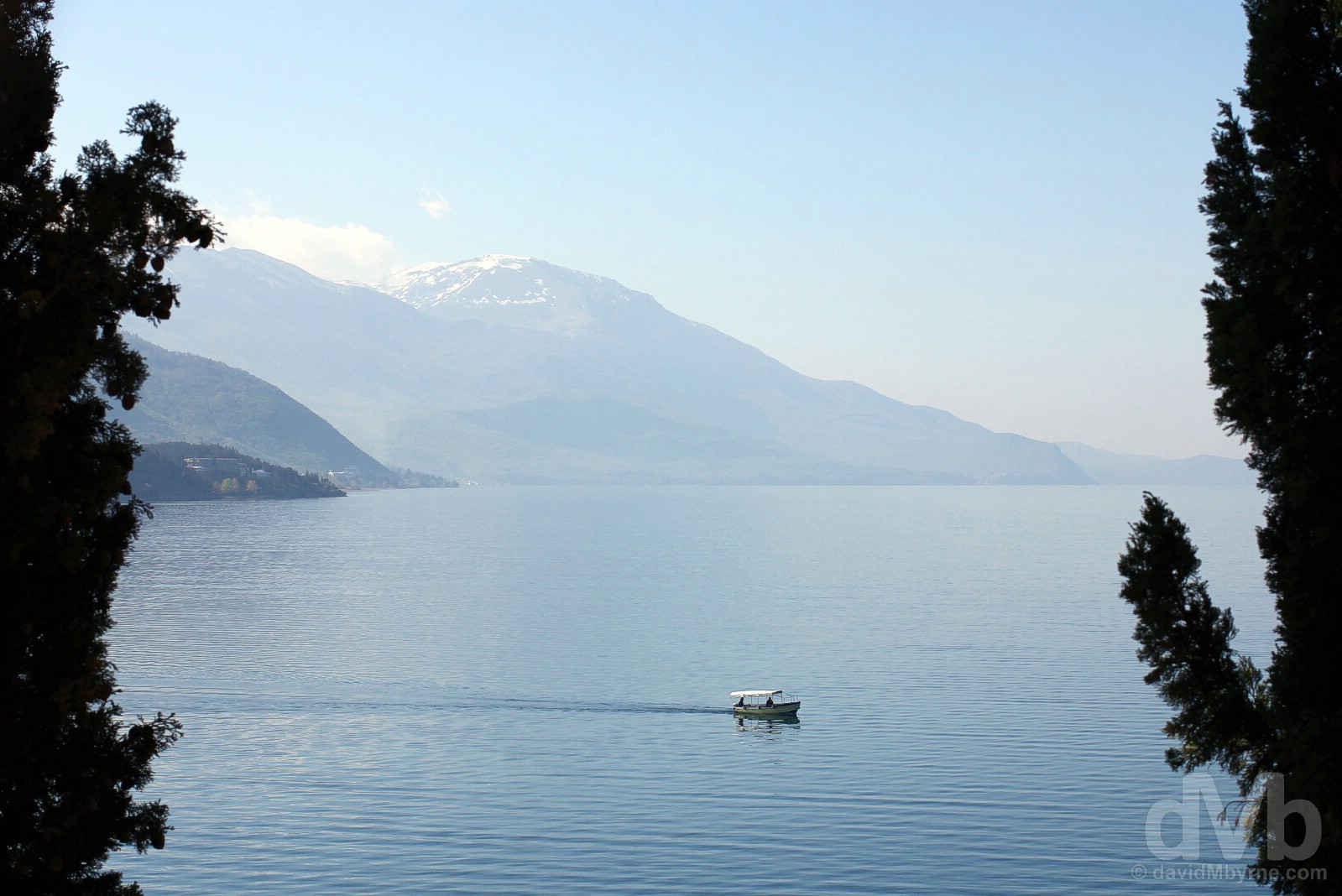Ohrid, Macedonia
Ohrid, on the Double: Village & Lake. The Historic & Stunning UNESCO-listed Region of Soutwest Macedonia”… when I arrived, again just as I did in 2007, I sat there, in the same place on the same wall in the same silence savouring the same sense of serenity and drinking in the same stunning serenity, waiting for the sun to set. I knew what to expect. It’s the exact reason I returned. And it didn’t disappoint.”
Image || Boating on Lake Ohrid, southwest Macedonia. April 25, 2017.
Ohrid, Macedonia
It’s not far from Tirana, Albania, to Orhid, Macedonia, easily the country’s most alluring destination resting by the shores of the lake of the same name – 130 kilometres, give or take. It’s slightly further from Skopje, the Macedonian capital, to Ohrid – 170 kilometres or so. It takes longer to drive those distances than one would imagine it should; the winding roads and the climb to the mountain pass that is the international Kjafasan/Qafë Thanë border crossing with Albania delayed proceedings on the journey from Tirana to Orhid in 2007; whereas yesterday, and almost a decade on from that first visit, the roads of central Macedonia slowed progress sufficiently on the journey from Skopje to Ohrid. Both times the outcome was the same – evening tranquillity by the calm shores of Lake Ohrid, Macedonia’s enchanting and UNESCO World Heritage-listed crowning glory. Some places are just worth revisiting however long it may take to get there.
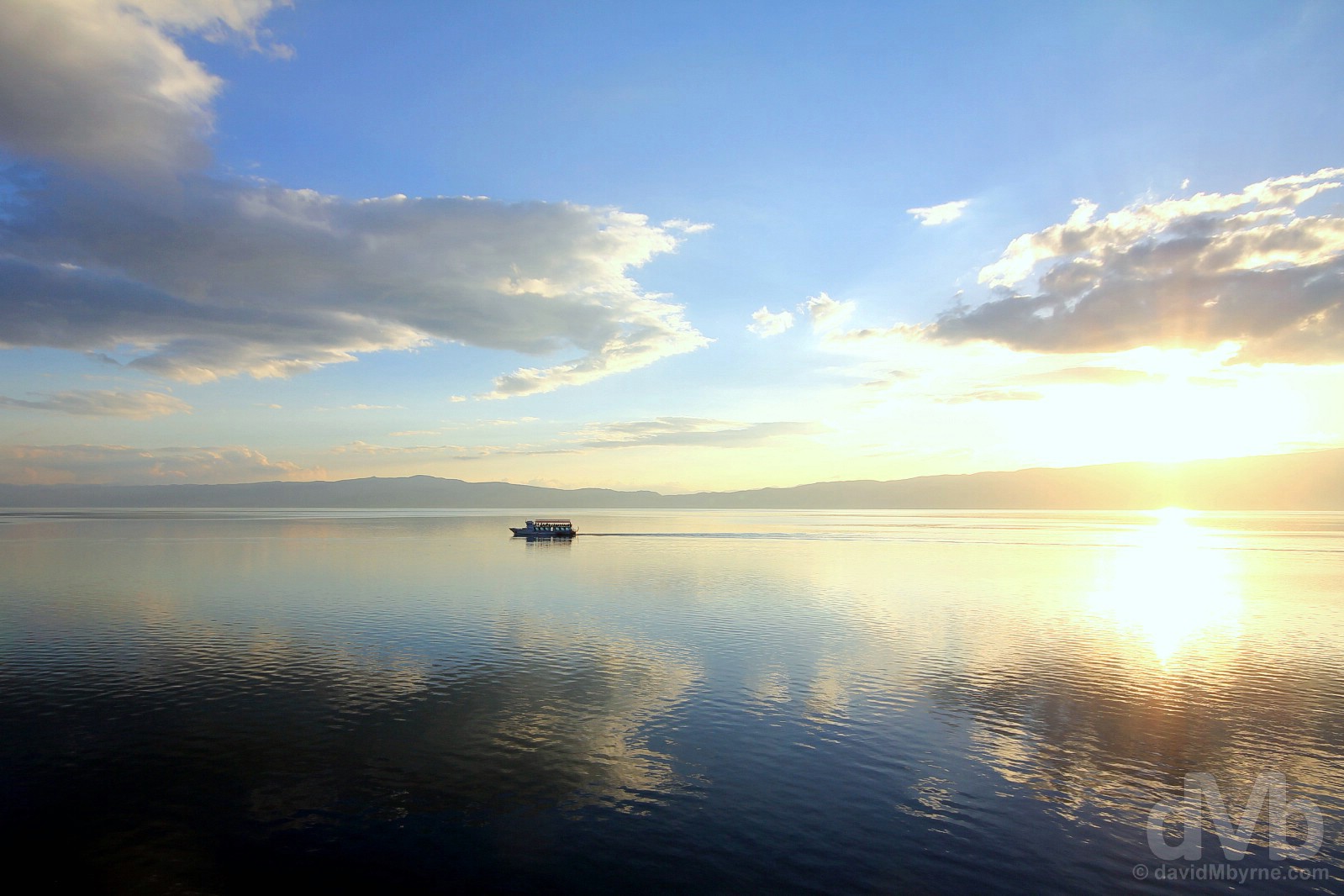
LAKE OHRID SUNSET || Boating on mirror-like Lake Ohrid nearing sunset as seen from the grounds of the St. Jovan Kaneo Church in the UNESCO-listed Ohrid region of southwestern Macedonia. April 24, 2017.
It’s a whole decade – September 2007 – since I last sampled a Lake Ohrid sunset. The lake, the UNESCO-listed jewel in Macedonia’s crown, and its sunsets are the reason I made the trek back here. It didn’t disappoint.
– UNESCO commenting on the Natural and Cultural Heritage of the Ohrid region
dMb Country Overview - Macedonia
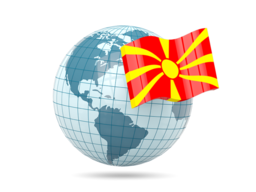 Macedonia
Macedonia
Region – Southeastern Europe/The Balkans (dMb tag: The Balkans). Capital – Skopje. Population – 2 million-plus. Official Languages – Macedonian, Albanian. Currency – Macedonian Denar (MKD) GDP (nominal) per capita – US$6,140 Political System – Unitary parliamentary republic. EU Member? – No (as of April 2017). UN Member? – Yes (admitted April 1993 using the name, under the instance of neighbouring Greece, Former Yugoslav Republic of Macedonia (FYROM)). G20 Member? – No. Size – 25,700 km² (Europe’s 14th smallest country is approximately half the size of Costa Rica and slightly larger than the US state of Vermont). Topography – Mountainous and rugged. Brief History – It’s complicated, as Balkan history tends to be. Inhabited since Neolithic times, the region was the homeland of one Alexander III of Macedon (aka Alexander the Great, born in Pella in present-day Greek region of Macedonia in 365 BC) who set forth from here to conquer the ancient world in the 4th century BC. The Romans held sway (from approx. 160BC), the Byzantines (from 395 AD), the Bulgarians, Serbia, and finally the Ottoman Turks who ruled for over half a century (from 1389 to 1912). Then came almost a century of more upheaval and Yugoslav Communist rule, before independence in 1991, something of a novelty up to that point for the long-oppressed Macedonians. Formation/Independence – 1991 following the breakup of the former Yugoslavia (and in what was the only peaceful withdrawal of the former Yugoslav army from any of its former republics). UNESCO World Heritage sites – 1. Tourism Catchphrase/Slogans – Macedonia Timeless. Famous For – Alexander the Great; Mother Theresa (born in Skopje); Lake Ohrid. Highlights – Shimmering Lake Ohrid, the jewel in Macedonia’s crown; remnants of the ancient past – Roman ruins and Byzantine-era churches; wilderness hikes; garish ‘New’ Skopje.
Name Note (2019 Update): – What’s in a name? A lot, seemingly. The naming of this little country has always been a thorny issue, one that has stoked tensions with neighbouring Greece for close on 3 decades now – Greece felt that the use of the name Macedonia following the mini-state’s independence from Yugoslavia in 1991 constituted a territorial claim on its own northern region of the same name (international recognition of Macedonia’s independence was delayed by Greece’s objection to the new state’s use of what Greece considered a “Hellenic name and symbols.” Greece finally lifted its trade blockade in 1995 and the two countries agreed to normalise relations, this despite continued disagreement over the use of “Macedonia” in the name). Since independence Macedonia was forced to call itself the rather convoluted Former Yugoslav Republic of Macedonia (FYROM) on the international stage, a title given to it by the UN and a title the Greeks were happy to roll with, even if 132 countries had recognised it as the Republic of Macedonia, its former constitutional name. In a bid to end one of Europe’s longest-enduring diplomatic rifts, and after years of negotiations, the country agreed, in 2019, to prepend the word ‘North’ to its name to help distinguish itself from the neighbouring northern Greek region, a move the Macedonians hope will accelerate its path to eventual EU accession. On my two visits to the country (in 2007 and 2017), the country was called (the Republic of) Macedonia and is thus referenced as such throughout my postings as opposed to its new official name of (the Republic of) North Macedonia.
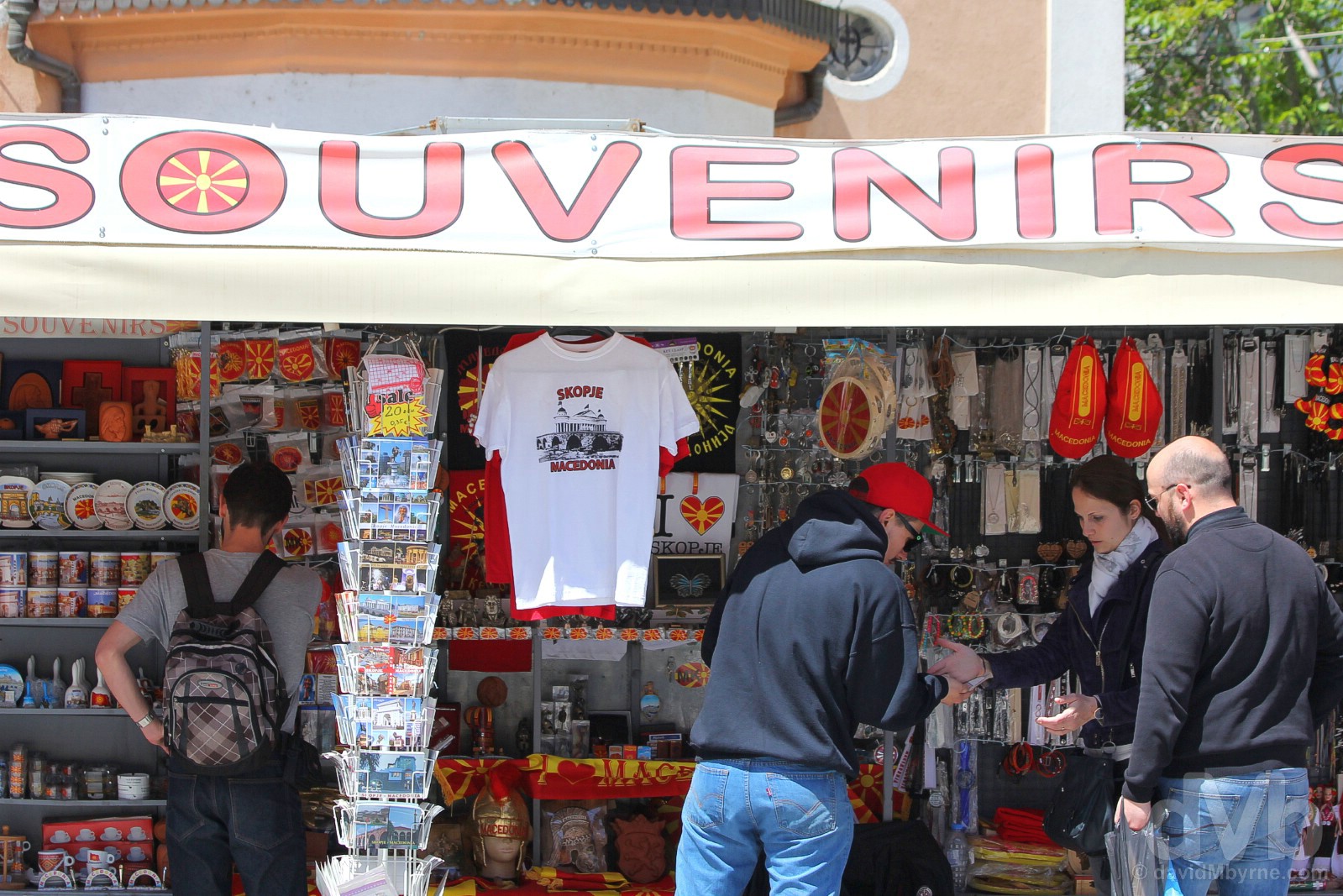
Souvenirs for sale in the Old Bazaar, Skopje, Macedonia. April 24, 2017.
Visits – 2 (April 2017 and September 2017). Where I went/What I saw – Ohrid (2007 & 2017); Skopje (2017).
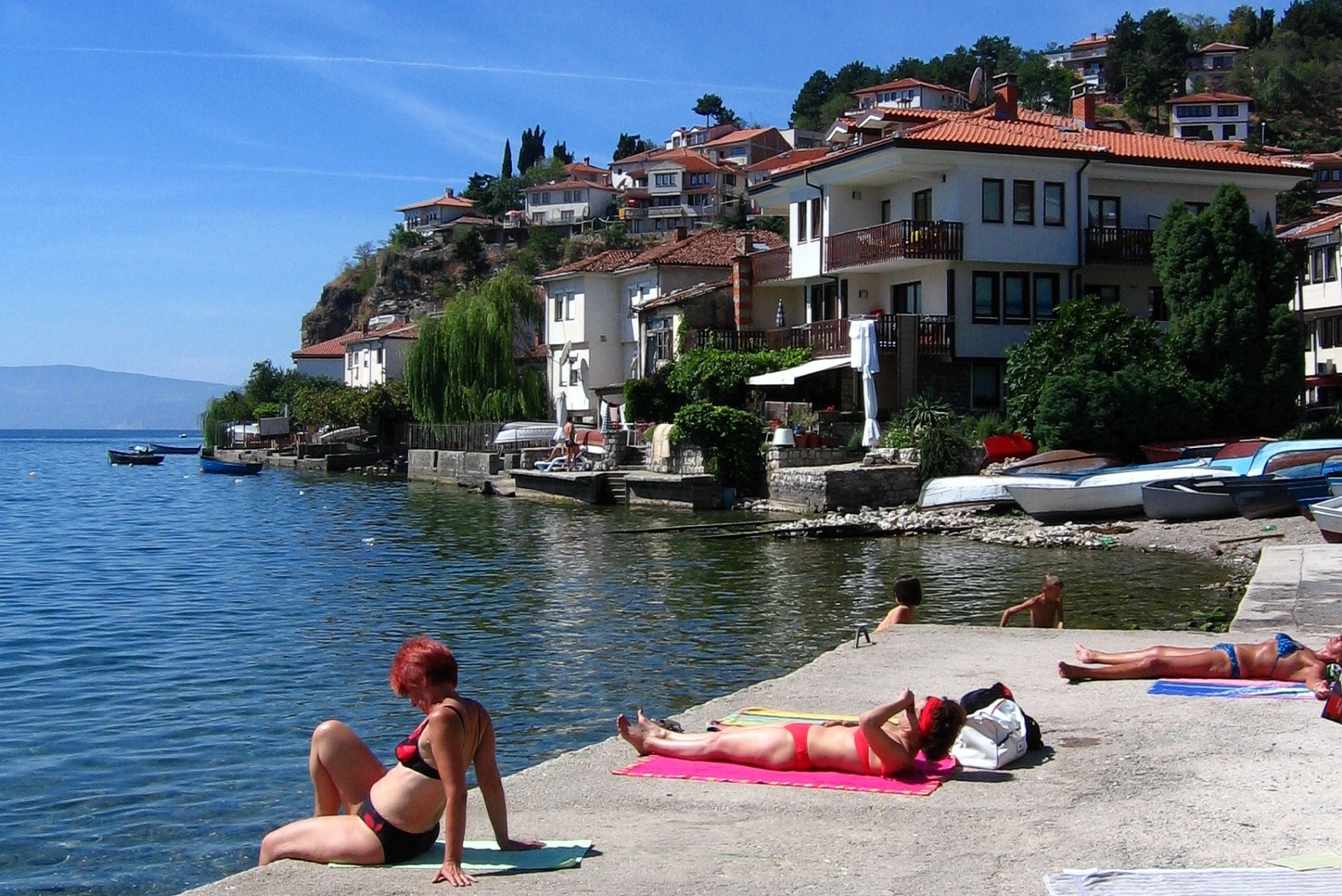
By the edge of Lake Ohrid in the village of Ohrid, southwest Macedonia. September 14, 2007.
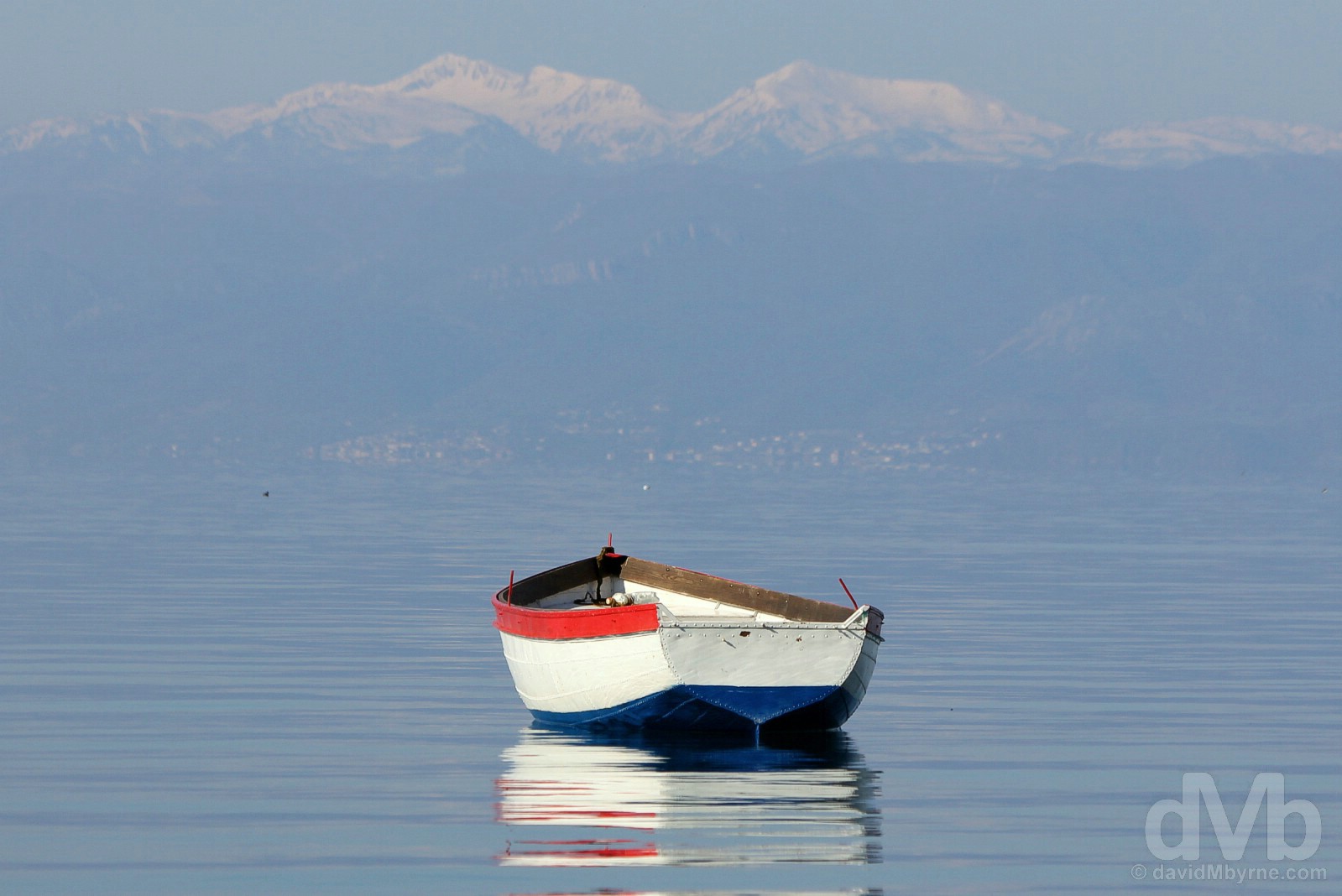
A boat moored in Lake Ohrid as seen from the lakeshore in Ohrid, Macedonia. April 25, 2017.
Ohrid On The Double
There are two versions of Ohrid here in this placid region of southwest Macedonia: one is a small hilly resort town with a compact walled Old Quarter of traditional houses with red-tiled roofs, medieval churches, monasteries, open-air ruins, and a centuries-old fortress towering above it all; the other is a shimmering lake straddling the mountainous border between Macedonia and Albania, one of Europe’s deepest, oldest, and most picturesque bodies of water harbouring a unique and UNESCO-protected ecosystem. Two reasons to visit when, for me at least, one would be draw enough. Fortunately, where Ohrid is concerned they come as a package.
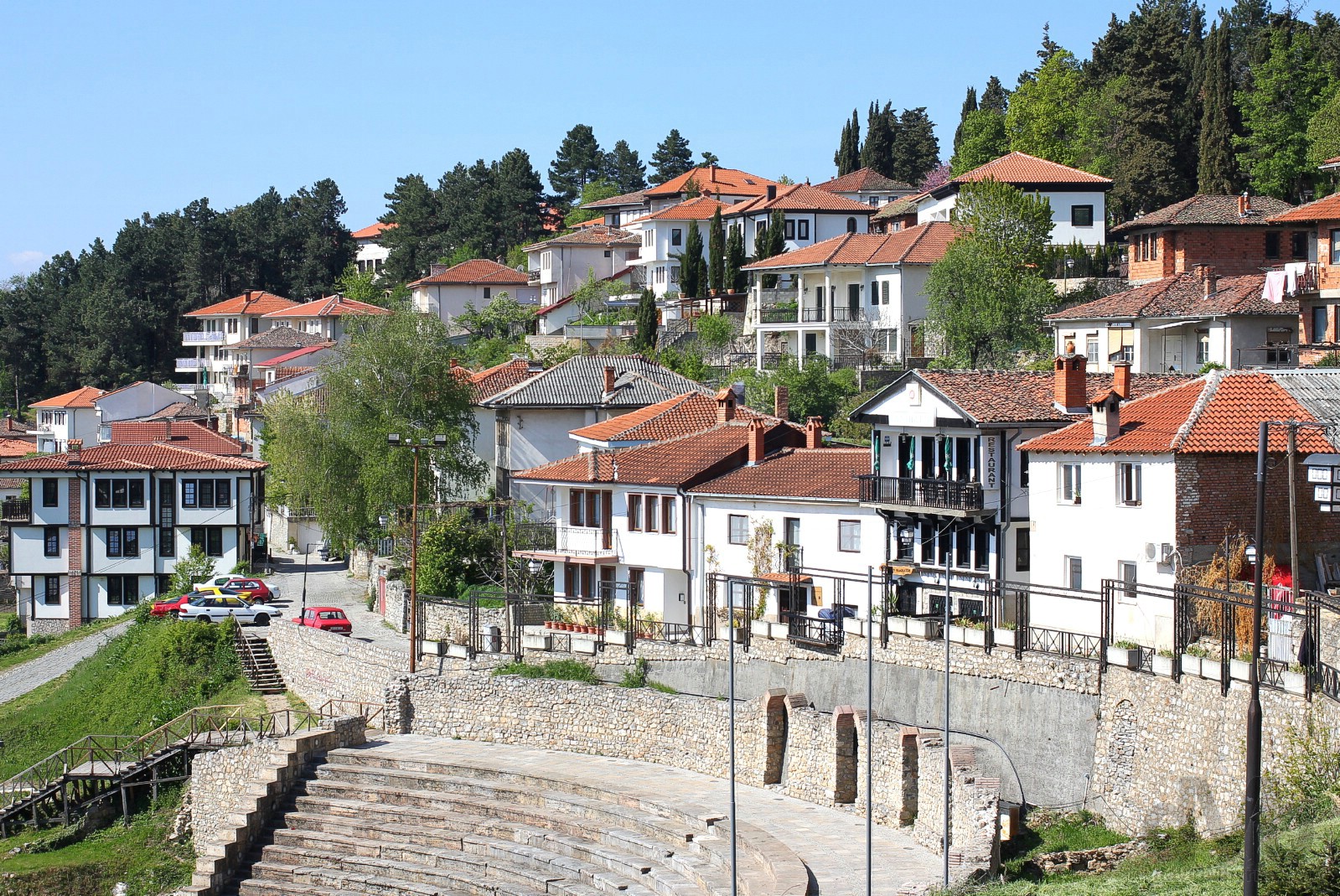
Buildings overlooking the Hellenistic-era Ancient Theatre in Ohrid, Macedonia. April 25, 2017.
Immortal Ohrid – a kingdom of light and water, a repository of ancient ruins from Macedonia’s earlier kingdoms – is the sublime lakeside town that for many represents the culmination of the Macedonian experience. And even if it doesn’t reach those lofty heights, it has to be one of the most laid-back and most picturesque places in the Balkans, a region renowned for its effortless, laid-back beauty.
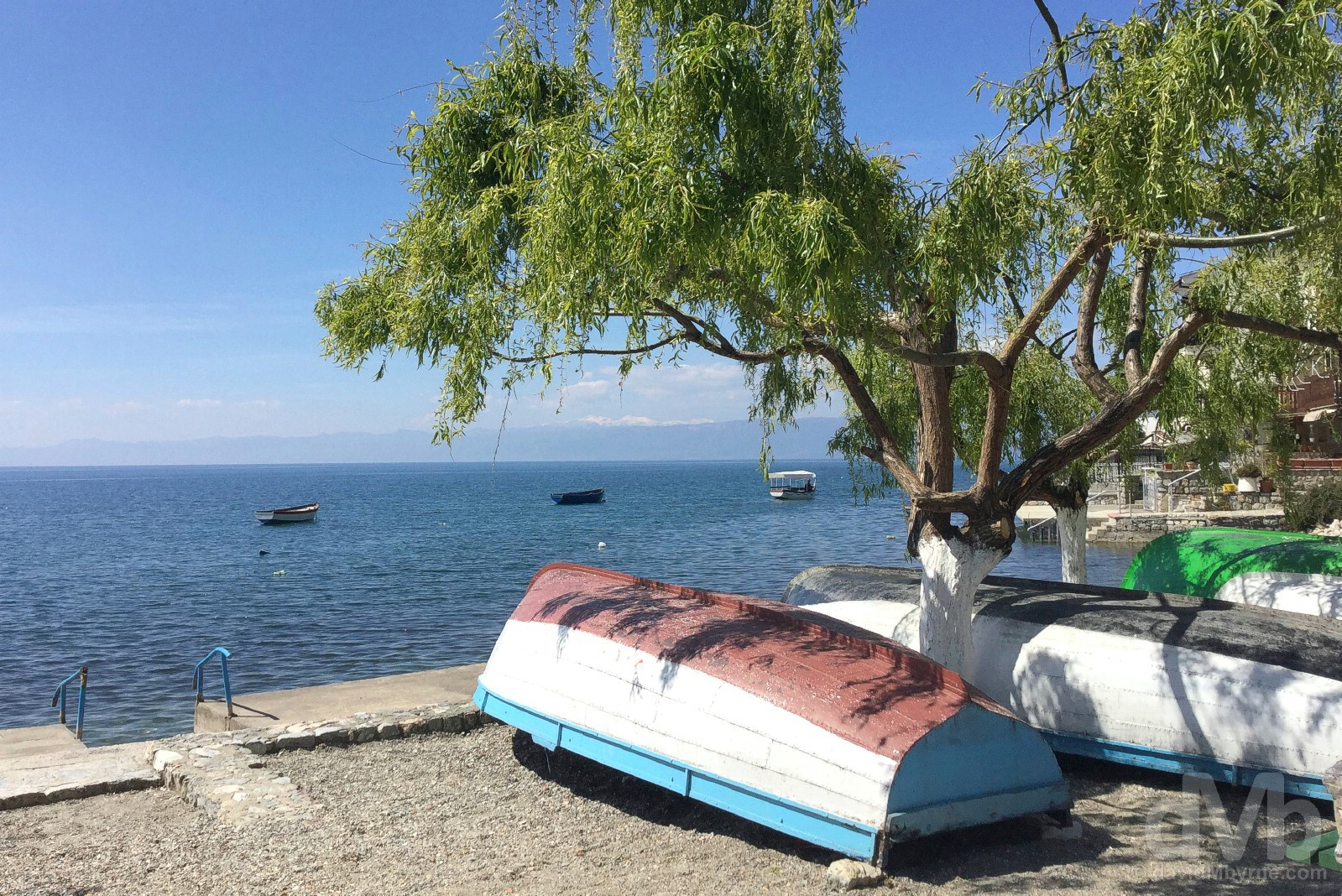
By the shores of Lake Ohrid in Ohrid, Macedonia. April 25, 2017.
Ohrid | An Escape
In these days of mass tourism, when insufferable crowds seem determined to conquer every corner of Europe, Ohrid is — shh! — still something of an escape. Just. OK, so you might consider giving it a wide bearth in July and August, when the tourist circus descends on the town and fill its lakeside cafés and the bars and traditional restaurants of the tight cobblestone streets of Ohrid’s atmospheric and walled Old Quarter. But relative to Europe’s well-established beaten-track destinations (pick one, any will do), this is still a corner of Europe that’s largely untouched by the hordes. Maybe it’s the region’s remoteness – it does take a bit of effort to get here – that has spared it from the masses. Whatever it is, Ohrid still offers a respite. For now at least.
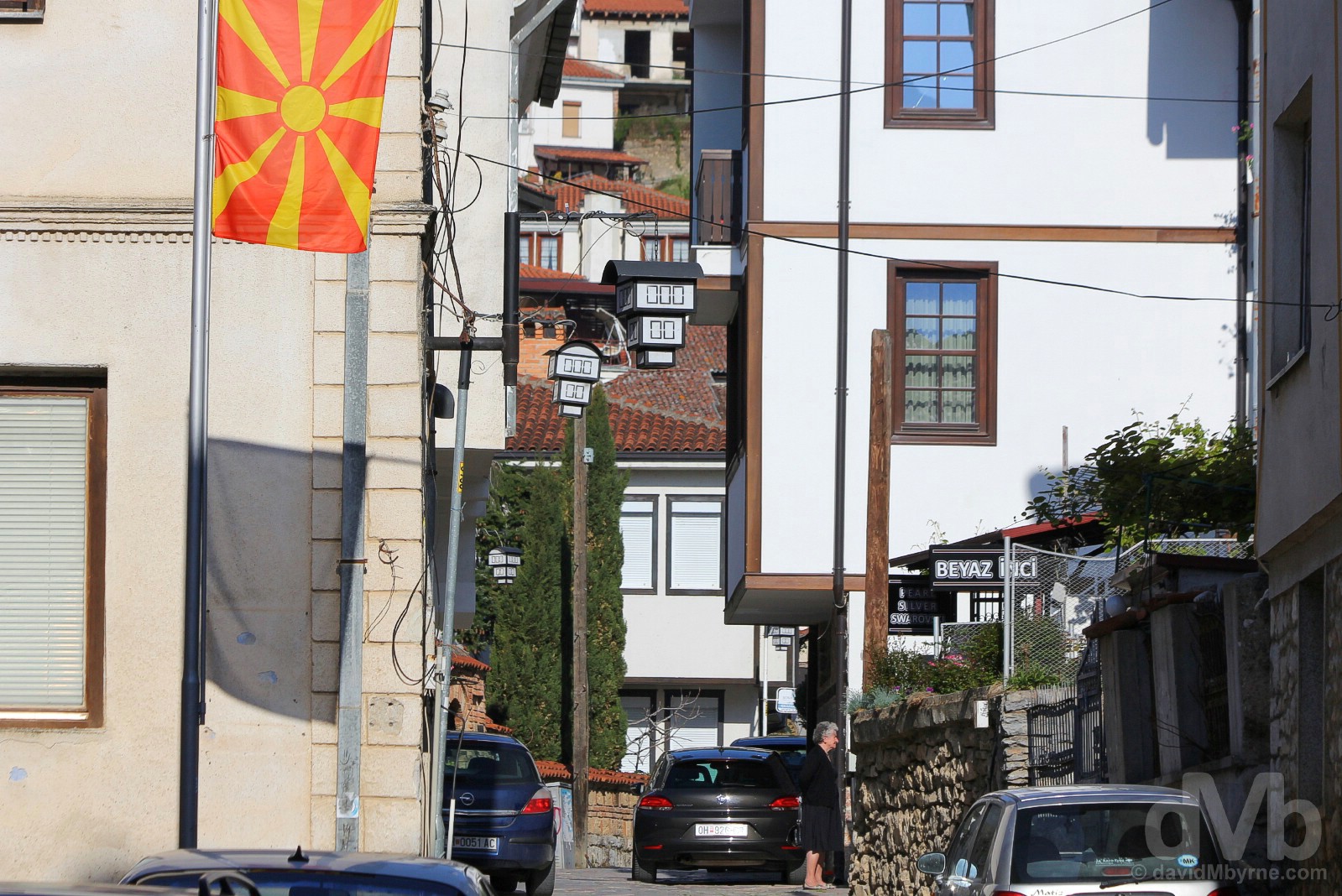
Old Quarter, Ohrid, Macedonia. April 25, 2017.
UNESCO World Heritage | 1979 & 1980
The town of Ohrid is one of the oldest human settlements in Europe – it was first mentioned in Greek documents from 353 BC. However, the charming tourist-friendly town found today nestling by the shores of the lake was built mostly between the 7th and 19th centuries. With its abundance of history, heritage, and architecture, not to mention the uniqueness of its lake, the Ohrid region has been granted UNESCO World Heritage status – the lake, albeit only the Macedonian side, in 1979 followed by the village in 1980.
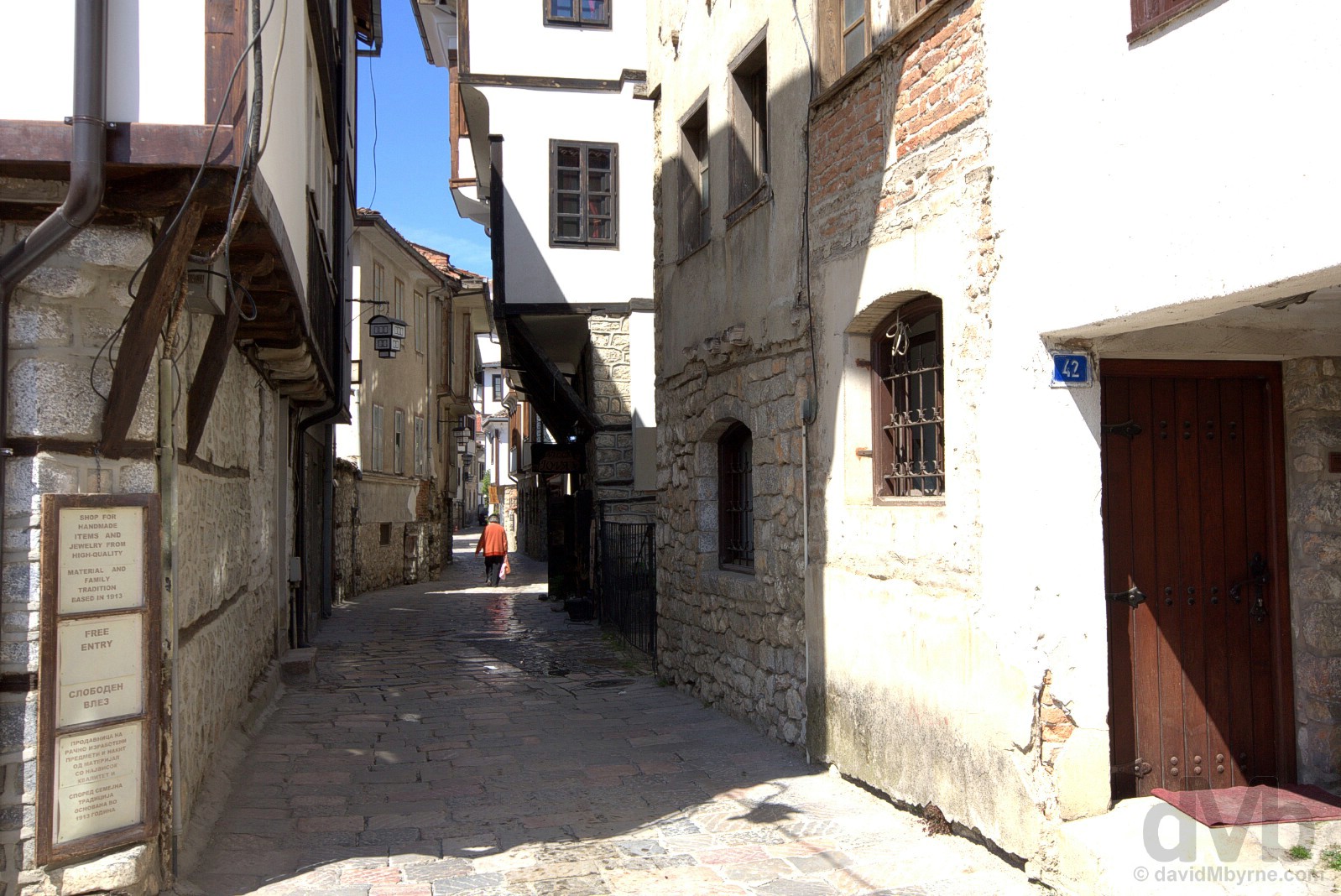
OHRID TRADITIONAL ARCHITECTURE || Traditional Ohrid architecture in the tight cobbled lanes of the Old Quarter, Ohrid, Macedonia. April 25, 2017.
Ohrid was built on a hilly, compact piece of land – essentially a huge cliff face – running down to the shores of Lake Ohrid. Given the lack of space and a restriction that prevented the town expanding outside of the town walls, Ohrid had no choice but to grow upwards thus developing a somewhat unique layout of narrow lanes enclosed by towering houses. The architectural style that developed here saw houses with tiny enclosed yards (usually hidden on the ground floor) and upper floor ‘tunnels’, or passageways, connecting neighbouring houses given their proximity to each other. Apart from the steep and limited terrain, regional climatic conditions also influenced Ohrid architecture – the houses were painted white to reflect the worst of the summer heat and open spaces were avoided because of winds blowing in off the lake. I guess it’s not always picture-postcard serenity around here.
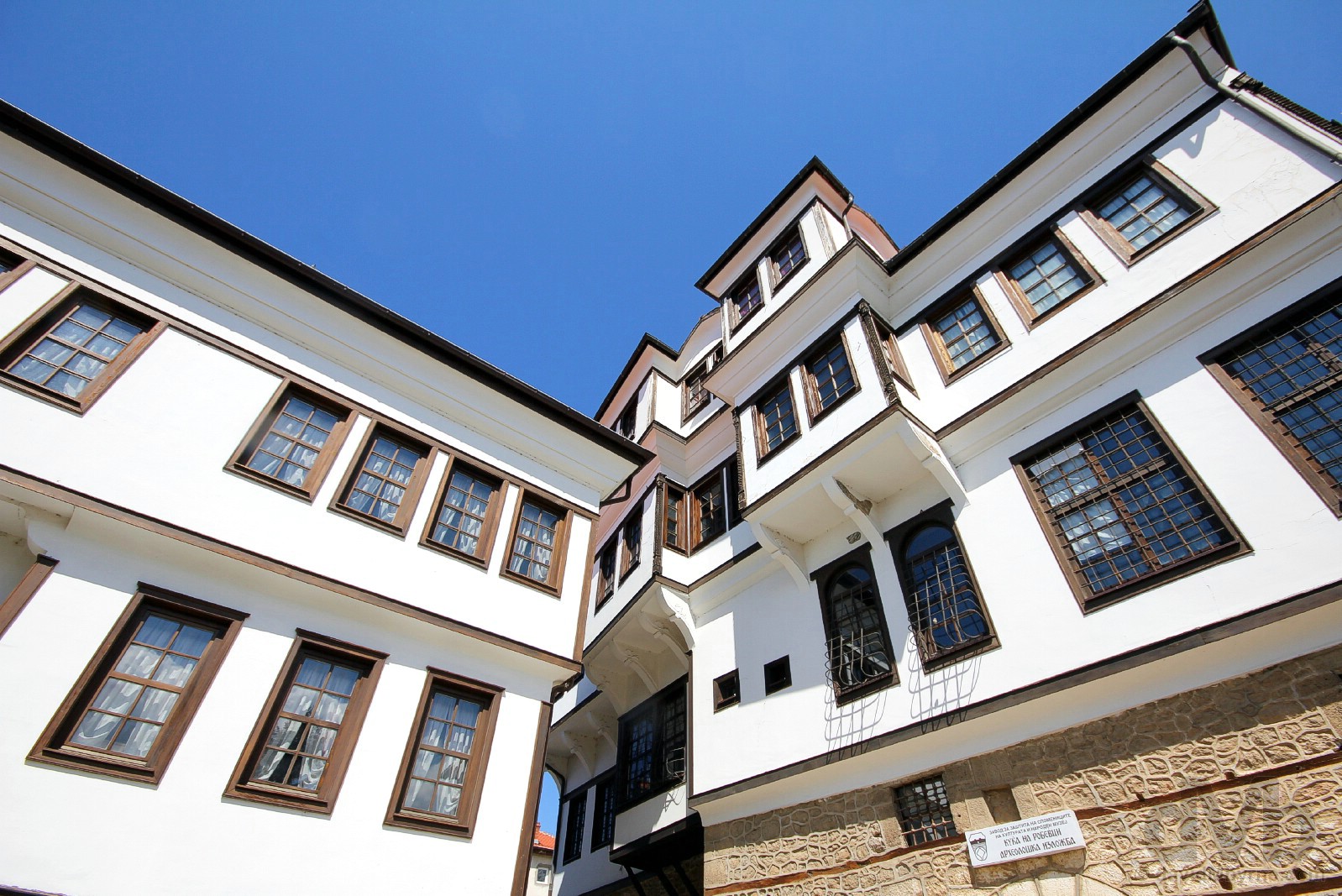
OHRID TRADITIONAL ARCHITECTURE – ROBEVCI & URANIA HOUSES || The Robevci House and The House of Urania in the lanes of the Old Quarter, Ohrid, Macedonia. April 25, 2017.
The Robevci House (right) and The House of Urania (left) are the most obvious examples of traditional Ohrid house archicture to be found towering over the cobbled lanes of Ohrid’s Old Quarter. These surviving structures, with entrances on different levels, were homes of well-to-do families; they are much larger than the average house in Ohrid’s Old Quarter. The Robevci House dates to 1827 but was rebuilt to its present form between 1863 and 1864. Today both houses act as museums displaying archaeological treasures of modern Macedonia. Their location, state of preservation (the Robevci House has been a protected structure since the end of World War II and was last renovated in the 1900s) and size marks them out as probably the photographic highlight of Orhid’s photgraphic Old Quarter.
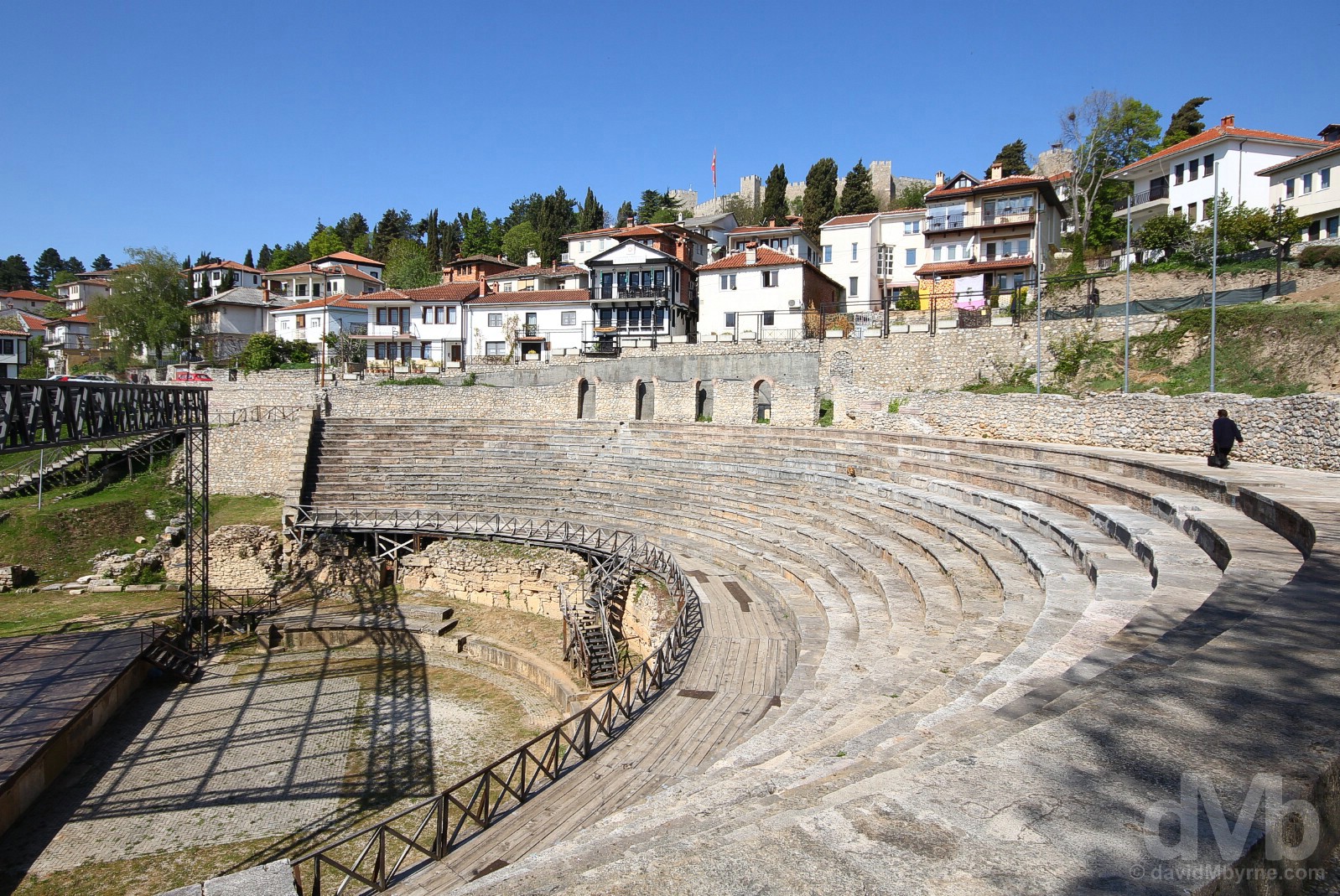
ANCIENT THEATRE || The Ancient theatre of Ohrid, Ohrid, Macedonia. April 25, 2017.
I remember witnessing archaeological excavations in the vicinity of Ohrid’s Ancient Theatre when I was first getting acquainted with the site back in 2007. It’s was only then that I began to full appreciate the antiquity on display in Ohrid. Dating to the Hellenistic period, the period of ancient Greek and Mediterranean history between the death of Alexander the Great in 323 BC and the emergence of the Roman Empire, the theatre was believed first built in 200 BC. Used as a stage for gladiator flights during Roman times, it was abandoned and buried by locals following the demise of the Roman Empire, this accounting for its good state of preservation when unearthed accidentally in the 1980s. Well preserved it may have been, but even so only the lower section of the theatre remains today. Situated between two hills that both protected it from winds and amplify its acoustics, it’s used today as an outdoor performance venue during the warmer summer months (and a stage that wasn’t in situ at the time of my first visit in 2007 has been installed in the meantime to facilitate the acts – see below).

2007 || The Ancient theatre of Ohrid, Ohrid, Macedonia. September 14, 2007.
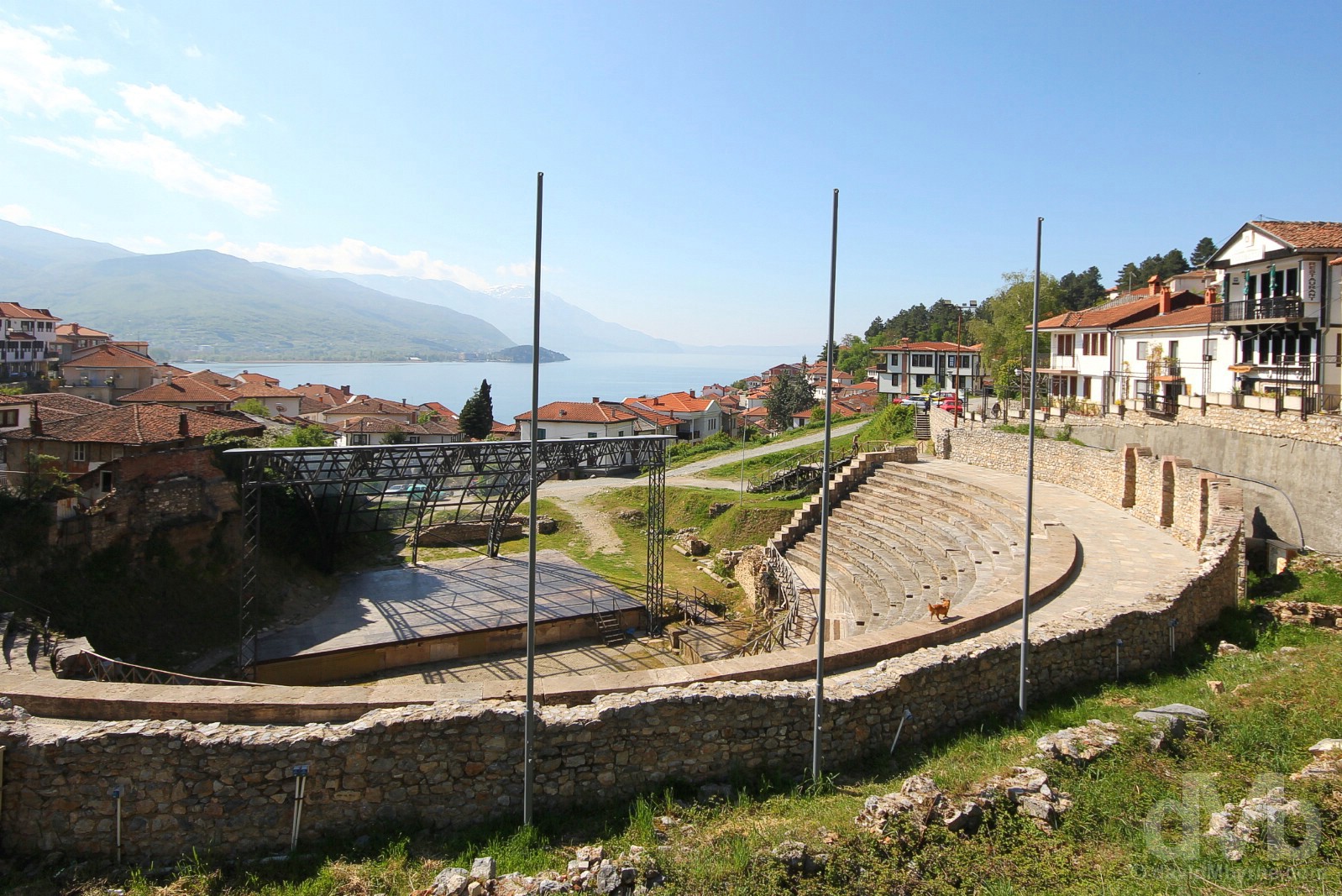
2014 || The Ancient theatre of Ohrid, Ohrid, Macedonia. April 25, 2017.
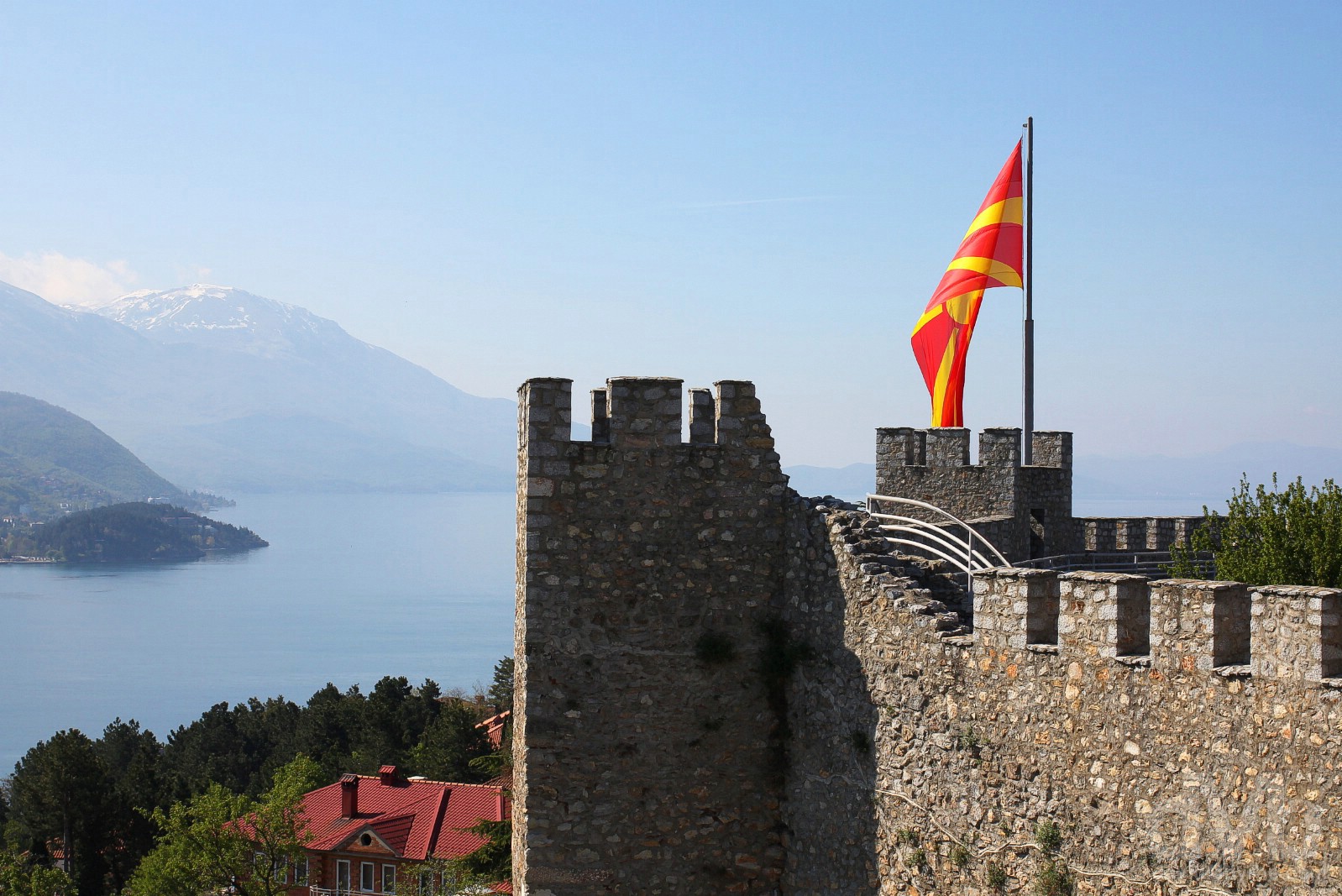
Overlooking Lake Ohrid from the walls of Samuel’s Fortress, Ohrid, Macedonia. April 25, 2017.
I didn’t visit Samuel’s Fortress on my 2007 visit to Ohrid. I’m not quite sure why, especially as it’s as obvious a beacon as the settlement has – it’s the highest point in hilly Ohrid and visible from anywhere in town.
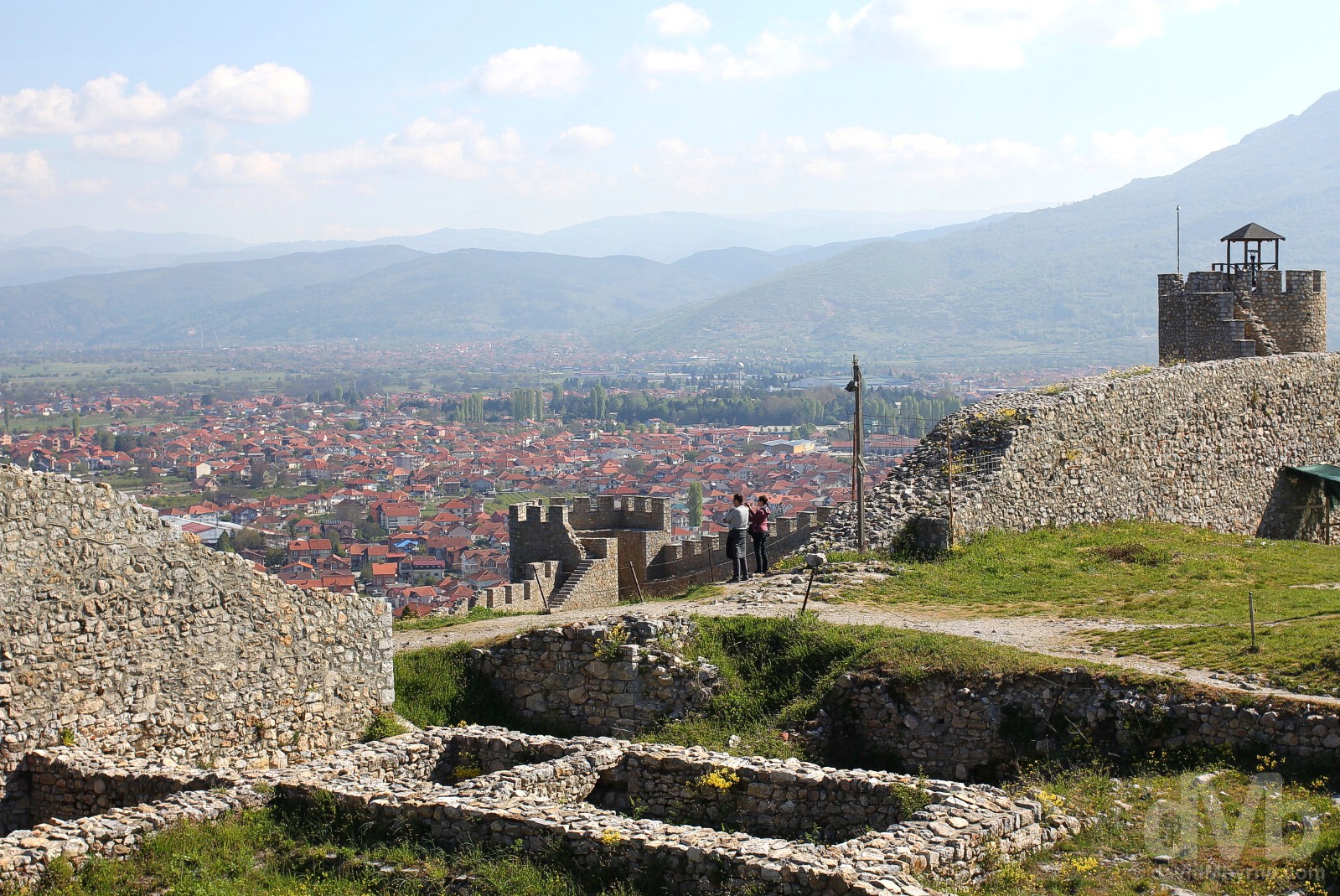
SAMUEL’S FORTRESS || Among the ruins in the grounds Samuel’s Fortress overlooking northern Ohrid, Macedonia. April 25, 2017.
At the beginning of the 11th century, Ohrid briefly became the capital of the Bulgarian Empire, ruled by Tsar Samuel who had a fortress built here on the highest point overlooking the hilly settlement. The small fortress, believed to have been built on the site of an earlier fortification dating as far back as the 4th century BC, still presides over the city today. Restored in 2003, when entirely new battlements were added where none had survived thus eradicating the obvious sense of antiquity that one gets ogling at other Ohrid ruins, there isn’t a whole lot on show (= nothing) in the compact hilltop space enclosed by the fortress walls; it’s the awesome views down over Ohrid that those walls afford that’s the undoubted highlight of a trek up here.
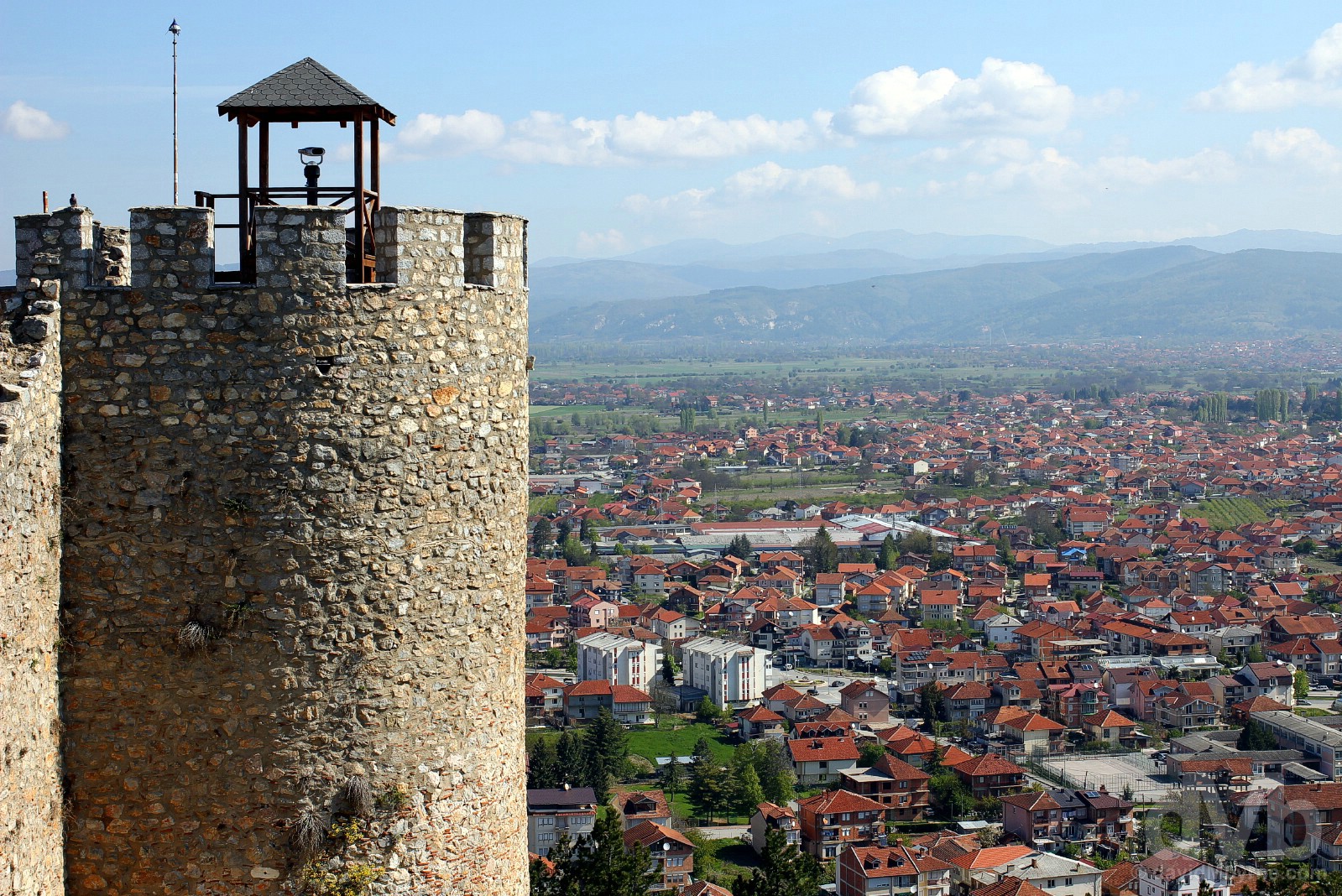
A tower of Samuel’s Fortress and a portion of northern Ohrid away from the compact Old Quarter as seen from the walls of the fortress. Ohrid, Macedonia. Apri 25, 2017.
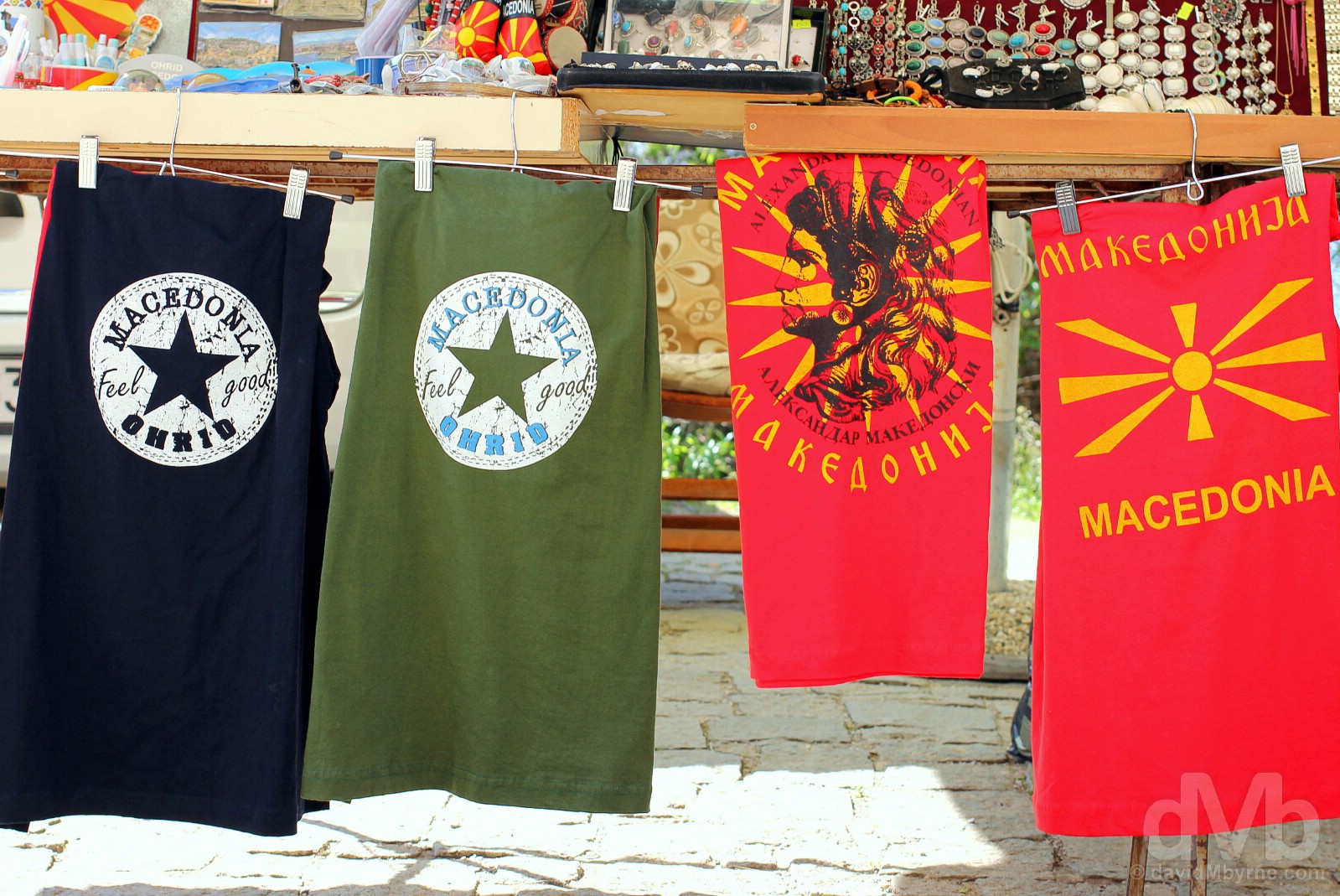
Souvenirs for sale outside Samuel’s Fortress in Ohrid, Macedonia. April 25, 2017.
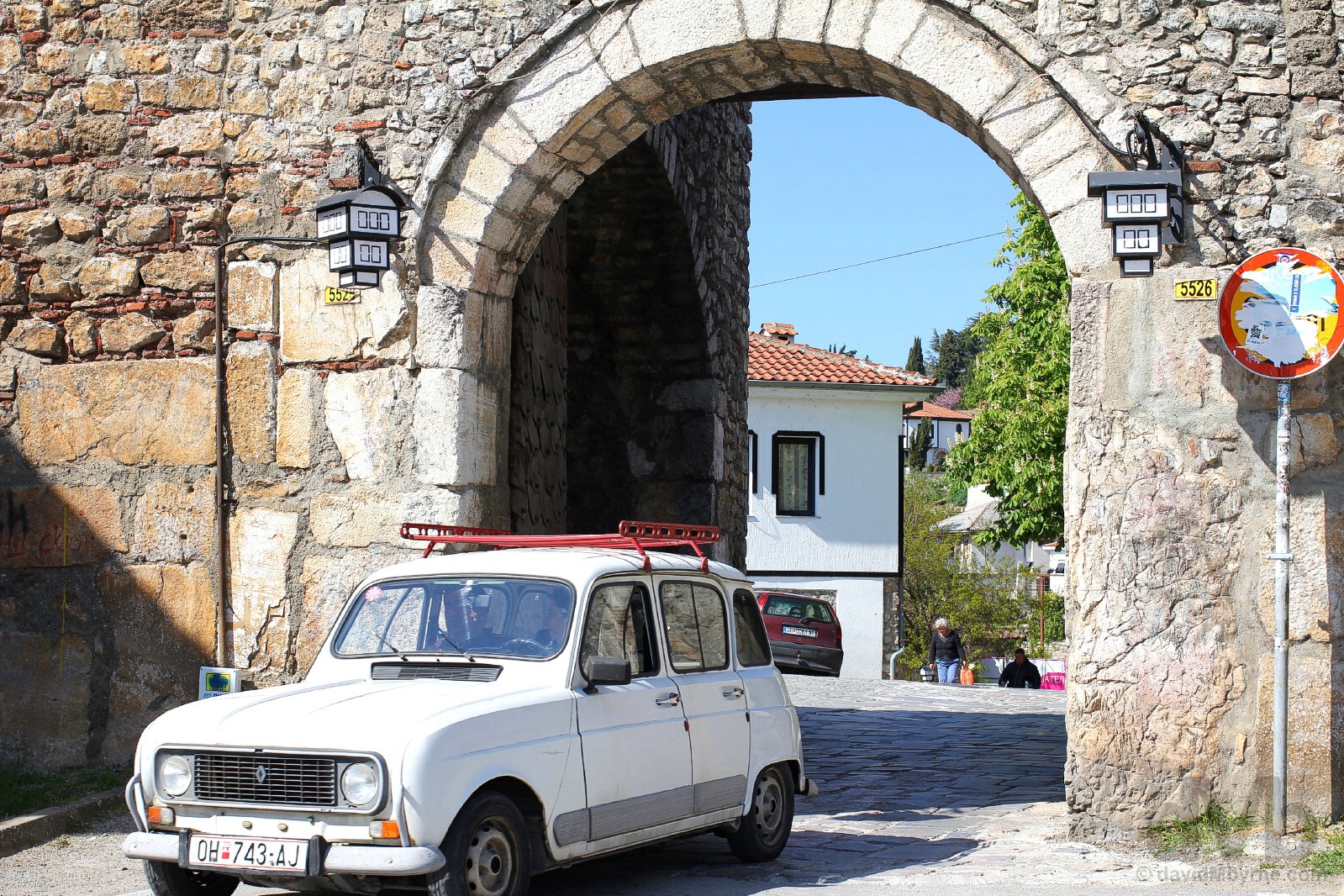
CITY WALLS/GORNA PORTA || Passing through Gorna Porta, the Upper Gate of the city walls in Ohrid, Macedonia. April 25, 2017.
With so much else to see in Ohrid, there’s not a lot of hullabaloo made over its ancient fortifications. Ohrid’s gates and walls date back to the 10th century, although those that still stand today, like the Gorna Porta, the uppermost gate to the Old Quarter and not far from the Ancient Theatre, were reinforced in the 16th century.
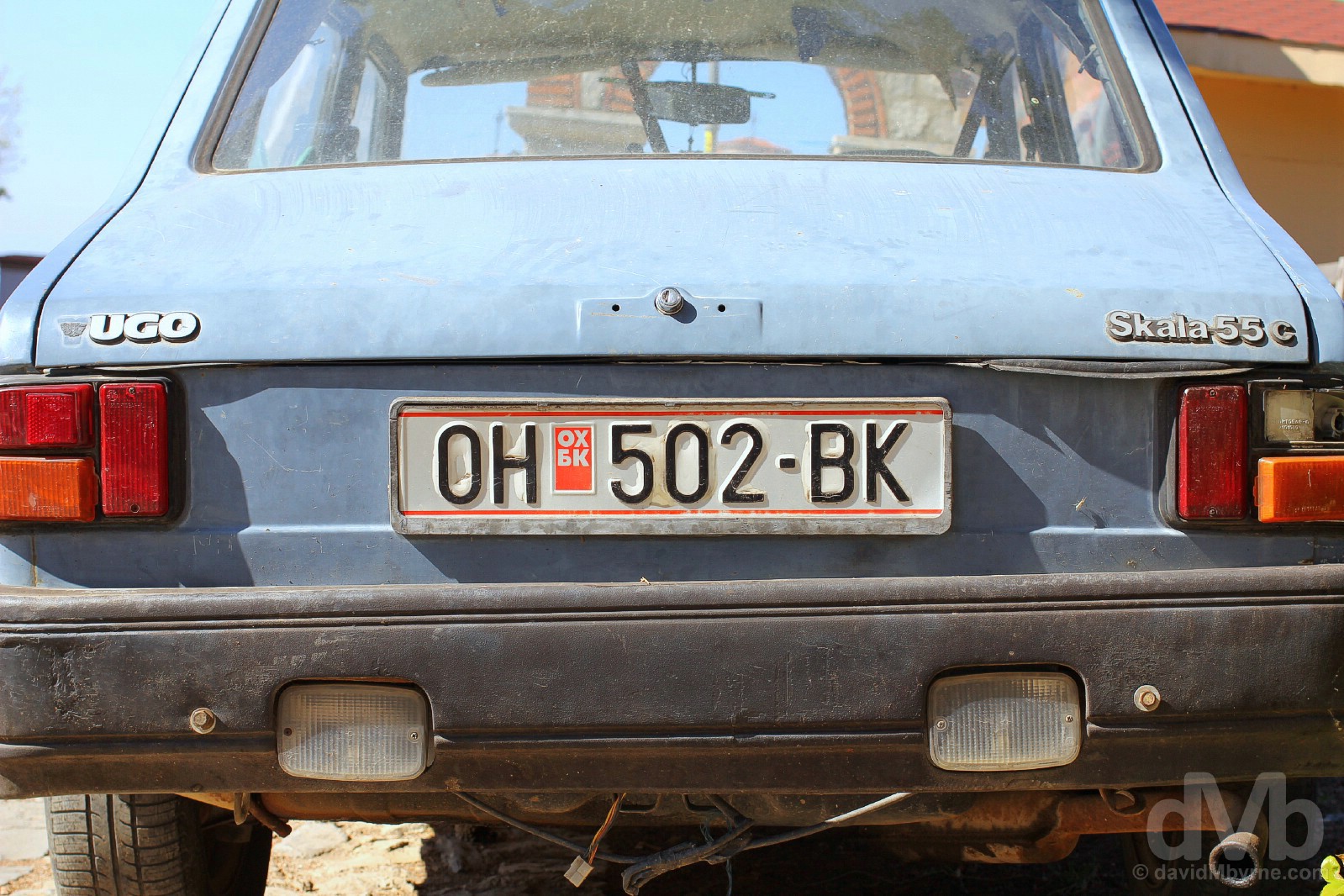
An old Serbian-made Zastava Skala/Yugo on Kuzman Kapidan, the road to the archaeological site of Plaošnik and the Church of Saints Clement and Panteleimon, in Ohrid, Macedonia. April 25, 2017.
– UNESCO commenting on the Natural and Cultural Heritage of the Ohrid region
During the Byzantine period, Ohrid became a significant cultural and economic centre, serving as an episcopal center of the Bulgarian Orthodox Church. Along with Preslav in modern-day Bulgaria, it became a site of the first Slavic universities in the 9th century. Given Ohrid’s present UNESCO-listed status as a former centre of Slavonic and Byzantine literary and culture, it’ll come as no surprise to learn that the place is awash with historic Byzantine-era structures. That said, some of the structures are not quite as old as one may think. Where Ohrid’s Church of Saints Clement and PanteleimonIn is concerned, it a case of reconstructing the past as a means of preserving it.
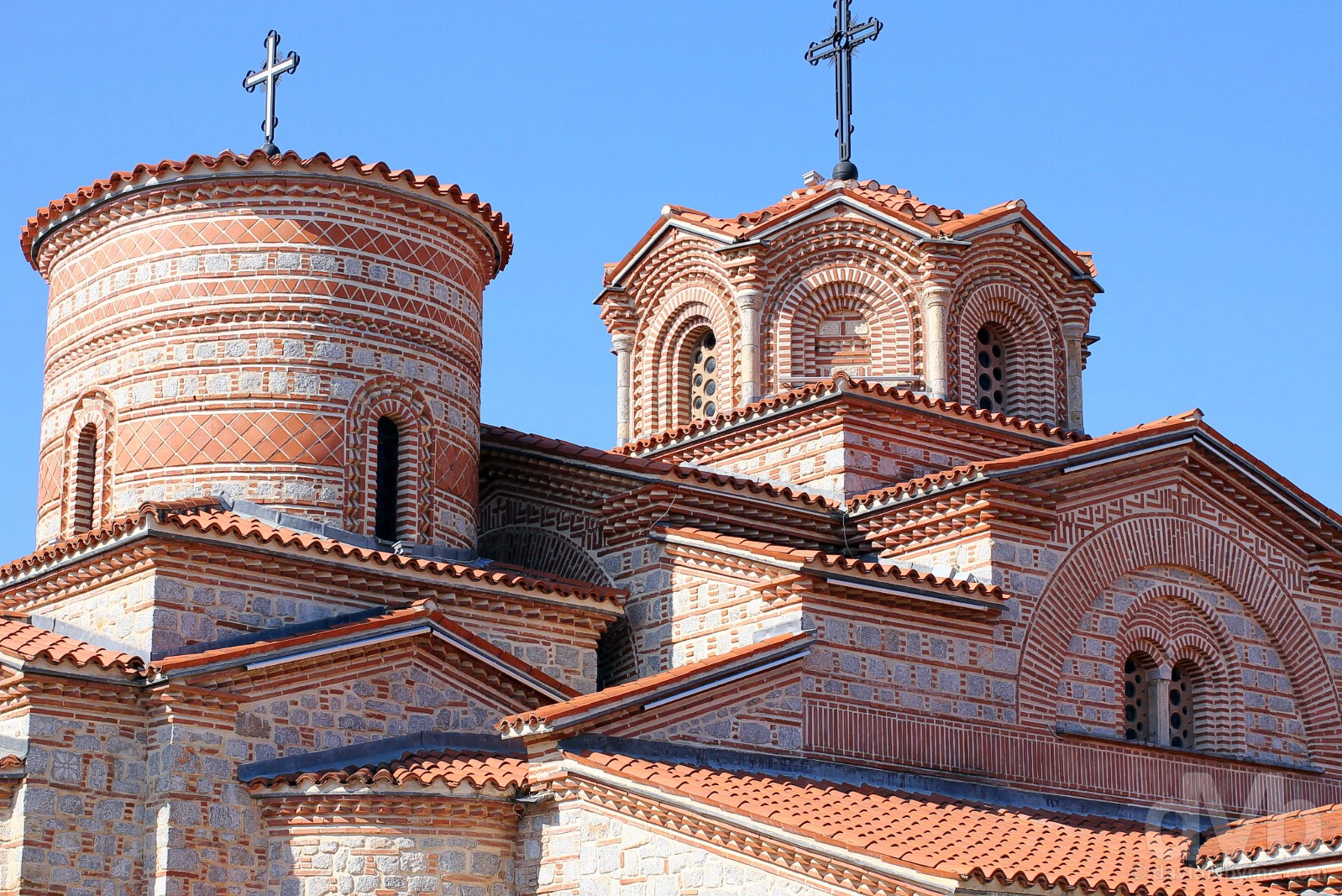
CHURCH OF ST CLEMENT & PANTELEIMON || The new Byzantine Church of Saints Clement and Panteleimon, Plaošnik, Ohrid, Macedonia. April 25, 2017.
Ohrid’s Byzantine Church of Saints Clement and Panteleimon was first built in c. 893 by Saint Clement, writer, scholar, enlightener of the Slavs and one of the first Medieval Bulgarian saints (his tomb is still on view here today). Believed designed by Clement himself, it was built on the site of a former church whose remains can still be seen among the work being carried out on the dusty hillside site surrounding the church; the surrounding site – Plaošnik – is a busy archaeological site that’s in the process of being restored to its perceived appearance during Clement’s time. The original church was reconstructed many times, especially during Ottoman rule when it was also replaced by a mosque. The most recent mosque was torn down in 2000 and the present structure – the result of a 2-year reconstruction carried out by hand and using materials used to build the original church in order to, it is said, preserve its original spirituality – was completed in August 2002. Considered the most sacred church in Macedonia, it and the surrounding Plaošnik site attracts thousands of Orthodox Christians who flock here during large religious holidays.
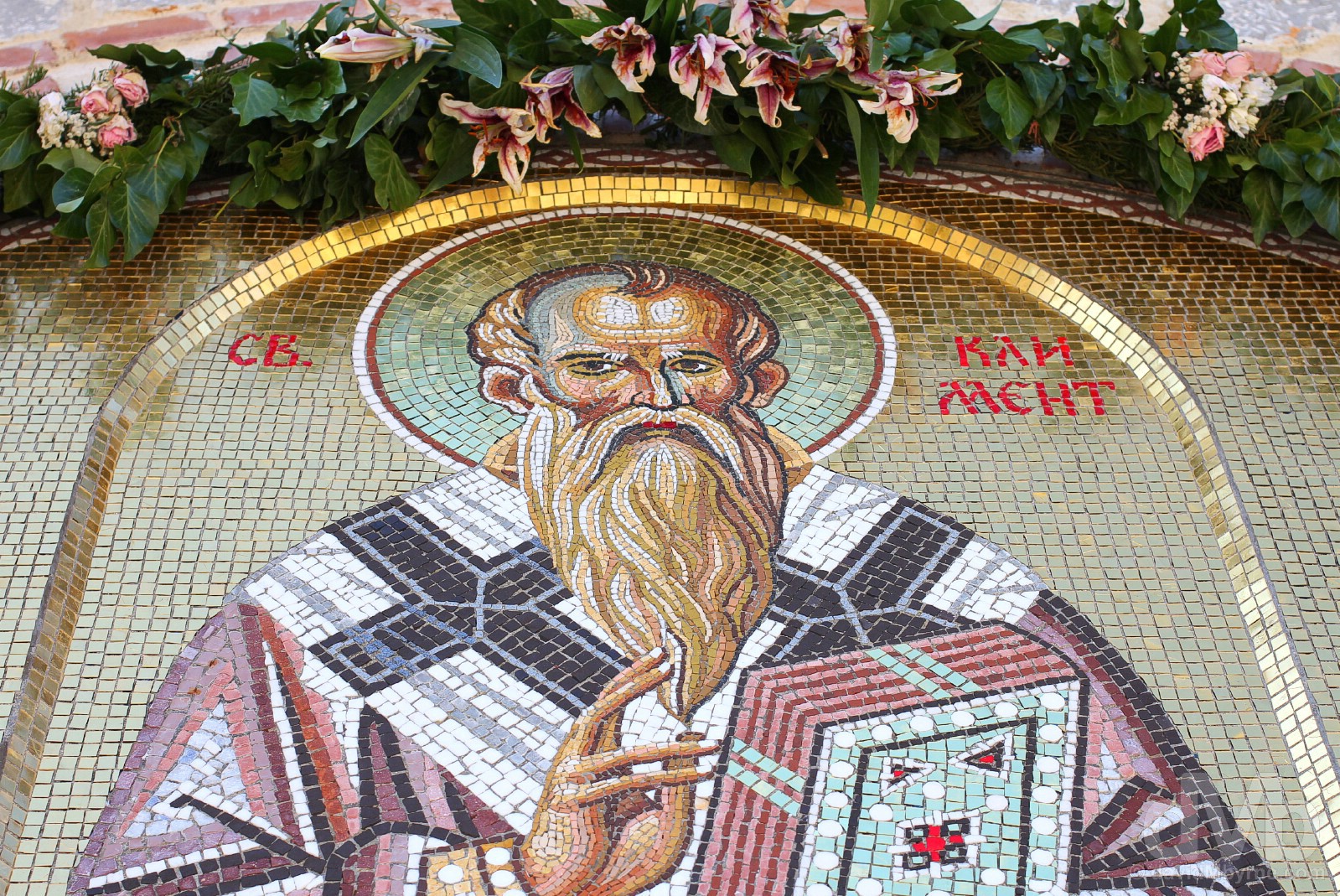
A finely detailed mosaic over the main entrance to the Church of Saints Clement and Panteleimon, Plaošnik, Ohrid, Macedonia. April 25, 2017.
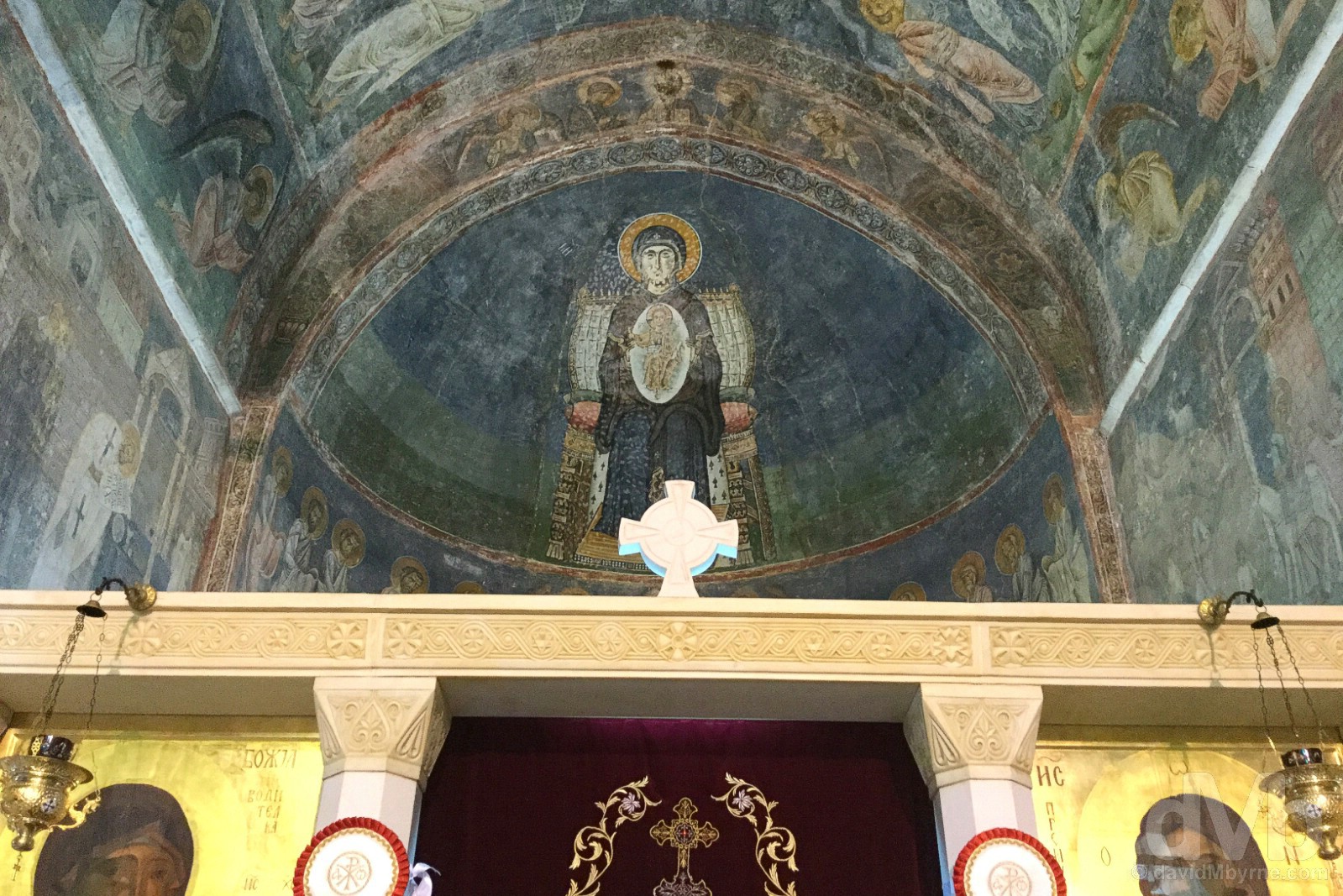
CHURCH OF ST SOPHIA || Frescos in the nave of the Church of St Sophia, Ohrid, Macedonia. April 25, 2017.
Built over the foundations of an earlier Christian basilica, Ohrid’s 11th century Church of Saint Sophia was built in 1035 and is the earliest preserved church in Ohrid. Like all Ohrid’s early structures, it has lived a changable existance, serving time as a mosque and being radically altered over the years. One of the most significant medieval monuments in the Balkan region, the church is renowned for the magnificence of its unique gallery of internal medieval wall paintings that date from the first half of the 11th to the middle of the 14th century, the world’s largest collection of 11th century preserved frescos.
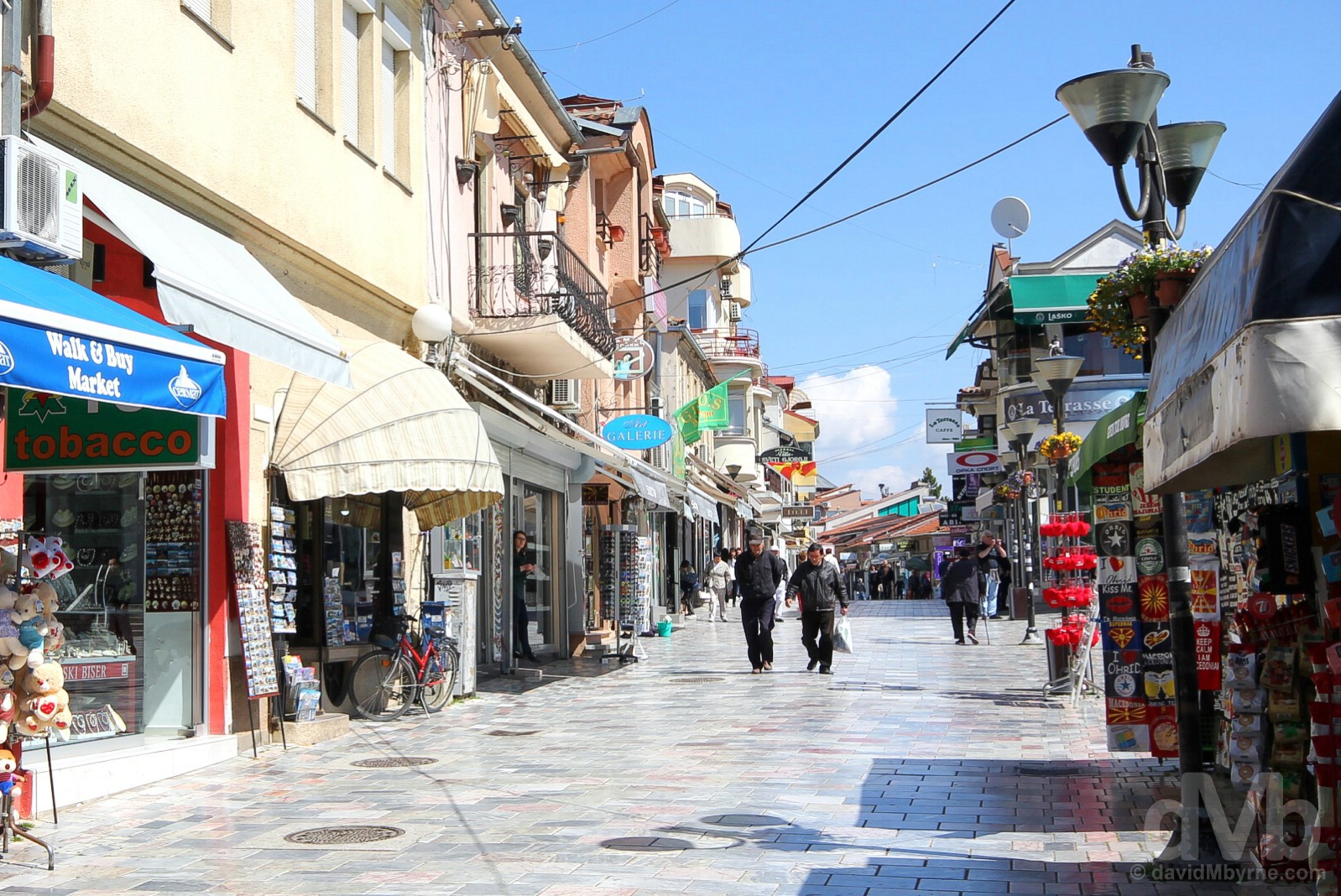
Sveti Kliment Ohridski/Old Bazaar Street, Ohrid, Macedonia. April 25, 2017.
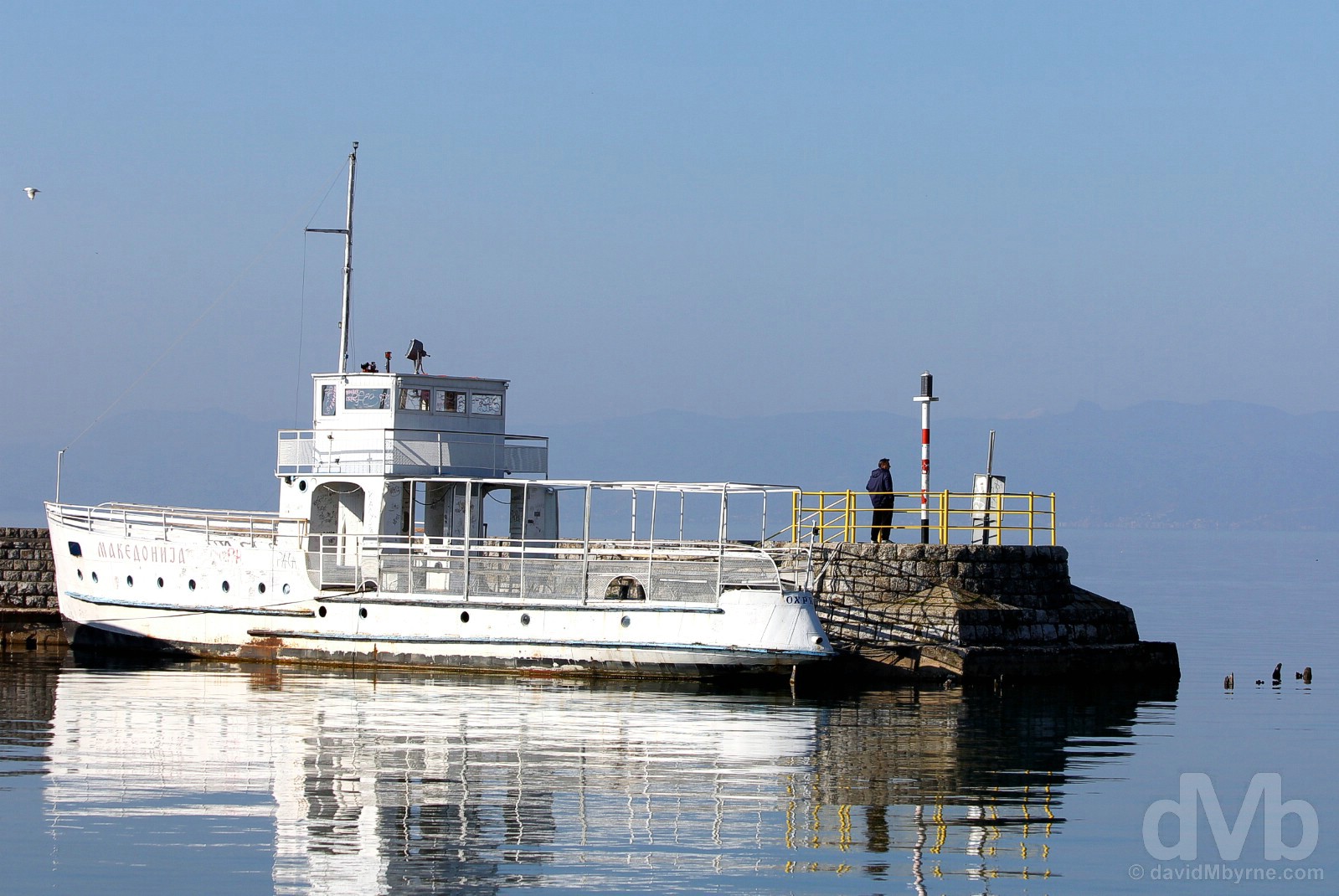
Early morning at the small Port of Ohrid Pier, Ohrid, Macedonia. April 25, 2017.
Ohrid | The Lake
Image || The iconic St. Jovan Kaneo Church overlooking Lake Ohrid on the outskirts of the village of Ohrid, southwest Macedonia. April 25, 2017.
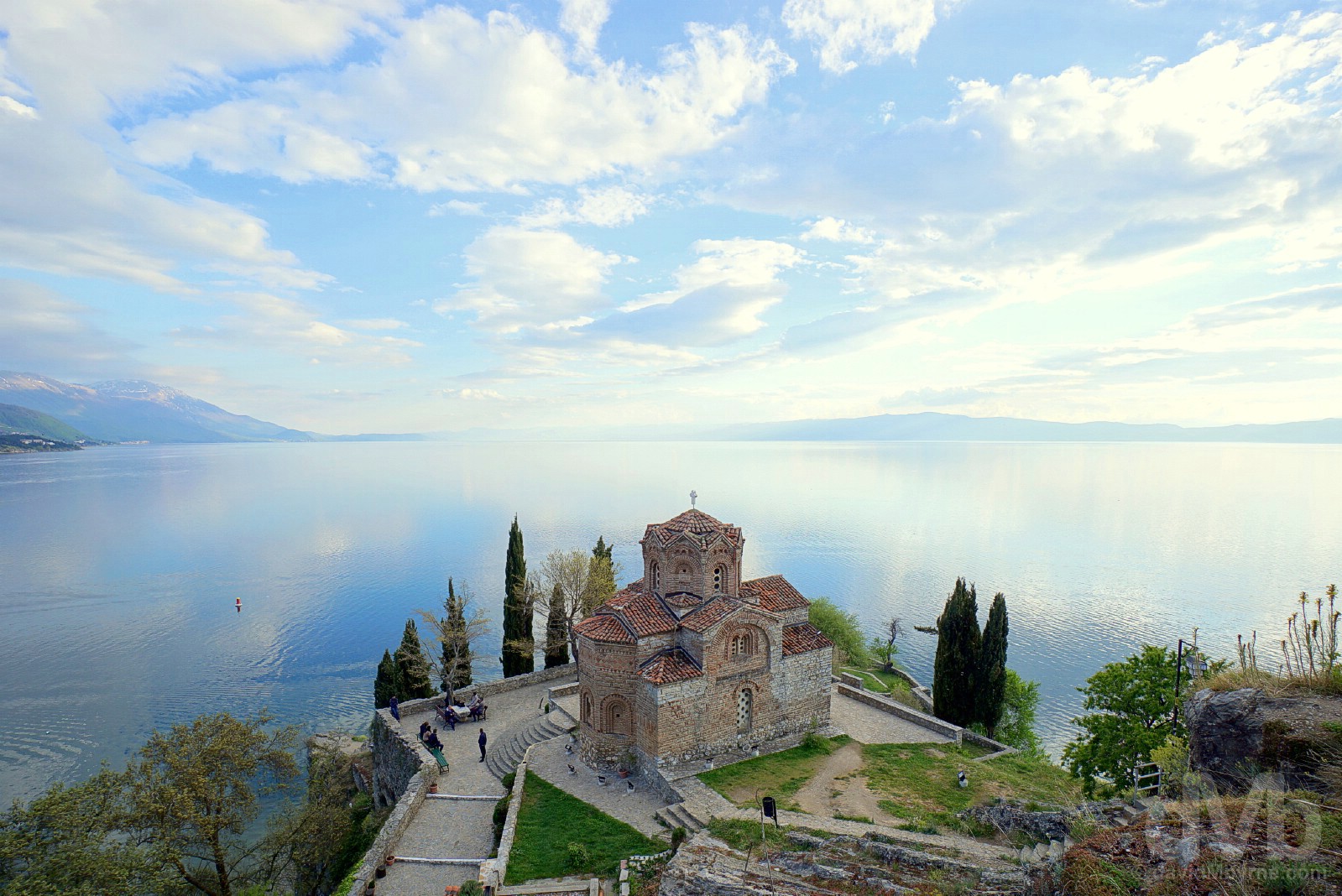
Waiting for an Ohrid sunset while overlooking the St. Jovan Kaneo Church perched on the edge of Lake Ohrid, southwest Macedonia. April 24, 2017.

Boating at sunset on Lake Ohrid, southwest Macedonia. April 24, 2017.
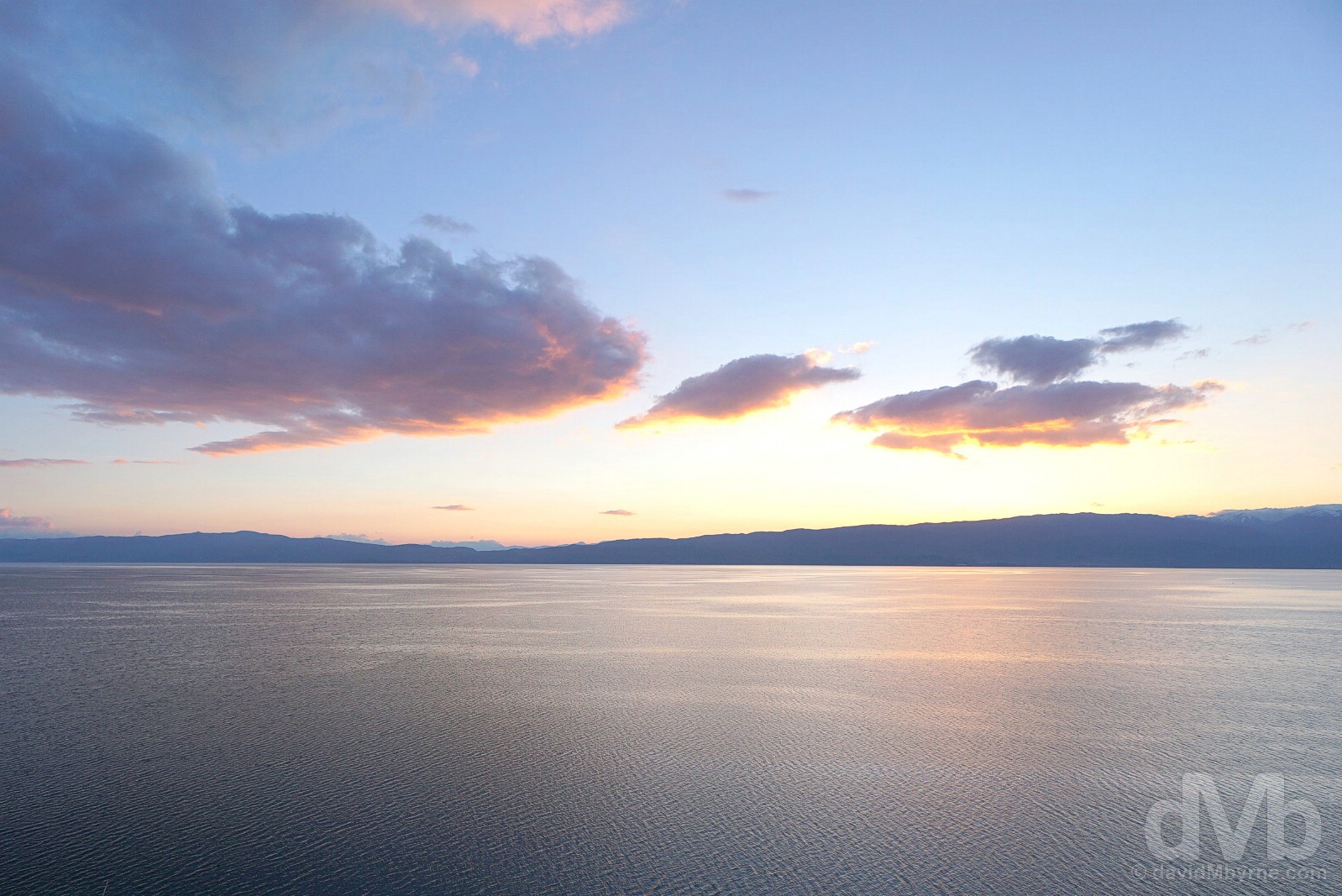
LAKE OHRID | Post-sunset calm on Lake Ohrid, southwest Macedonia. April 24, 2017.
Sublime Lake Ohrid, the jewel in Macedonia’s crown, straddles the mountainous border between southwestern Macedonia and eastern Albania. With a surface area of approximately 380 km² (150 sq mi), it’s not a particularly big body of water, but it is still one of Europe’s deepest and, at over three million years old, one of its oldest lakes. It’s also one of the oldest biotopes in the world – the lake boasts a unique aquatic ecosystem with more than 200 endemic species, enough to see it declared a World Heritage Site by UNESCO in 1979, although only the Macedonian side of the lake (UPDATE: The Albanian side of the lake attained UNESCO World Heritage status in 2019). Things, I hear, can get rough around here but I’ve only ever seen the lake at its shimmering, placid, and photographic best. I know of no other type of Lake Ohrid.
Early today I revisited the St. Jovan Kaneo Church, this time approching from Ohrid village via the elevated series of shore-skirting boardwalks installed to service the shacks and resturants doing business on the lake’s small and stony Potpesh and Kaneo beaches.
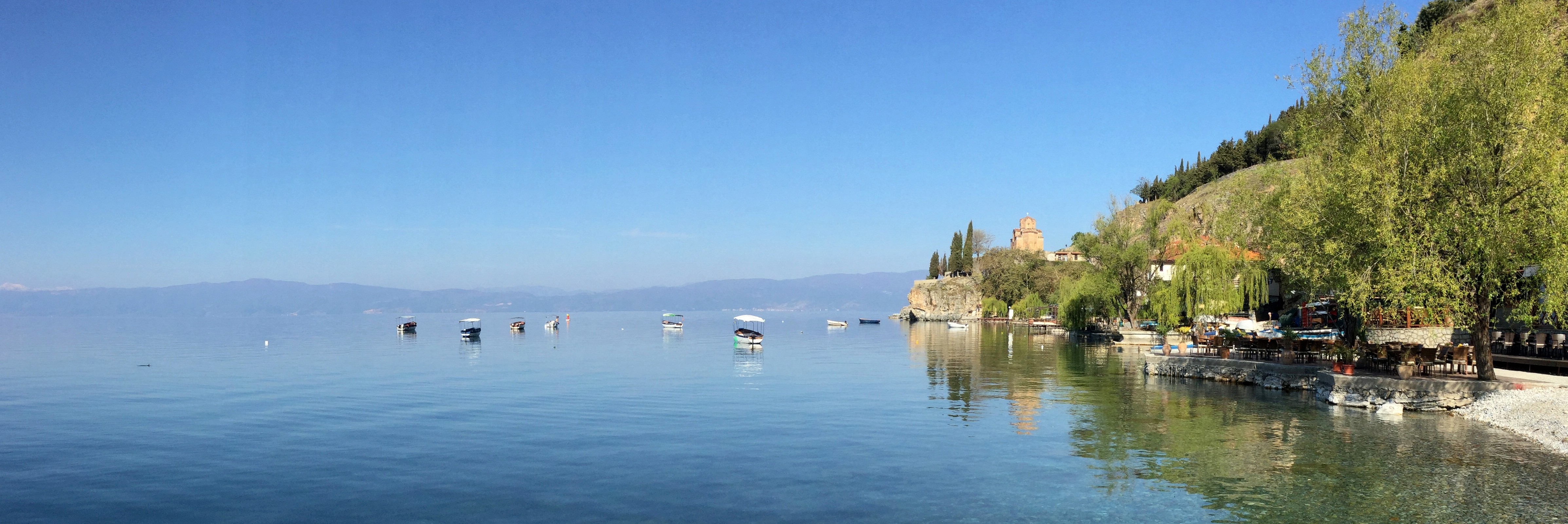
Early morning at Lake Ohrid. The St. Jovan Kaneo Church perched on the edge of Lake Ohrid as seen from the lake’s small and stony Potpesh beach, southwest Macedonia. April 25, 2017.
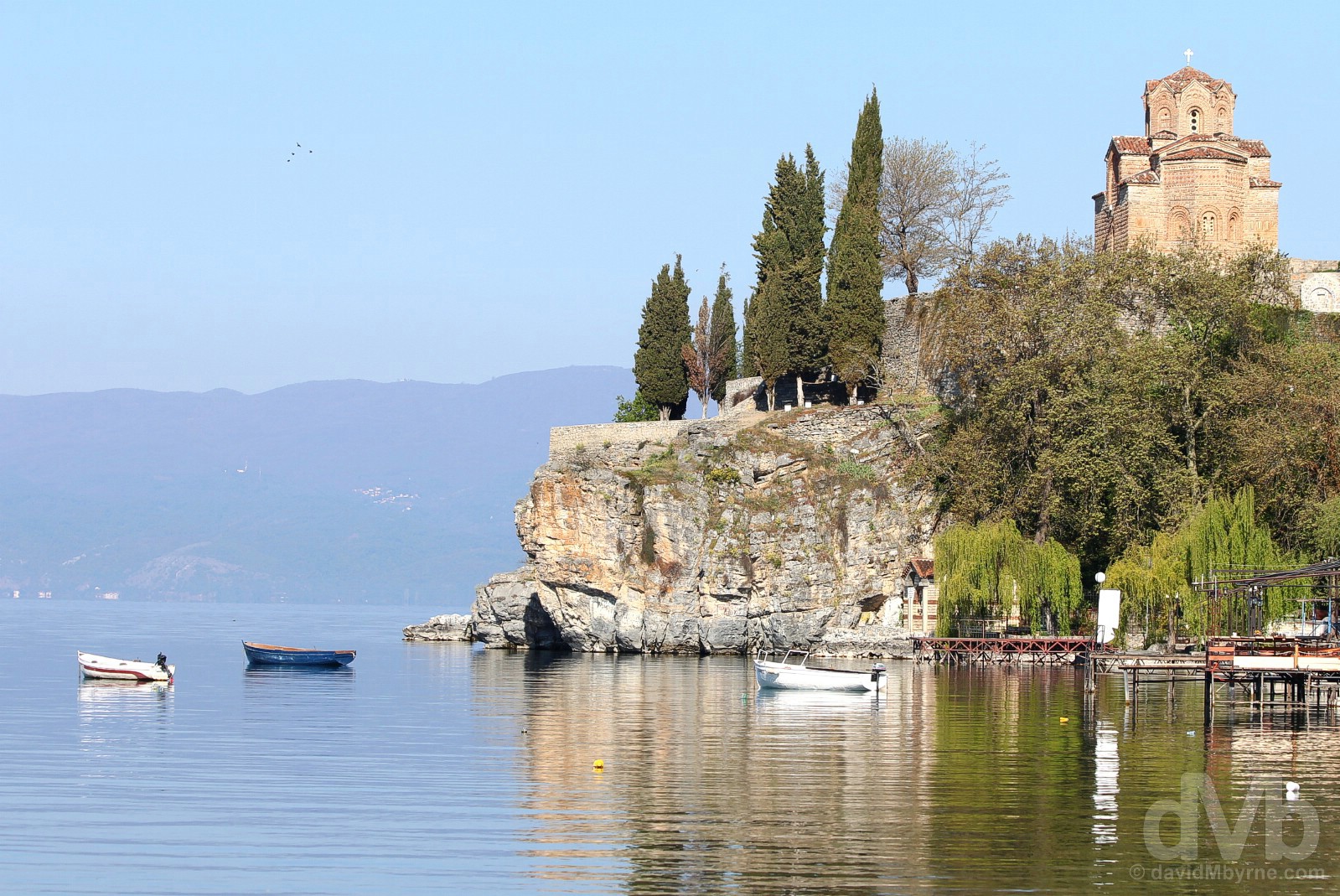
ST JOVAN KANEO CHURCH || The St. Jovan Kaneo Church perched on the edge of Lake Ohrid, southwest Macedonia. April 25, 2017.
Perched on a cliff overlooking the peaceful lake, the small Macedonian Orthodox St. Jovan Kaneo Church is Macedonia’s most iconic building and easily its most photographed. A lot about the structure is unknown including its age (it is believed to have been built prior to the rise of the Ottoman Empire, sometime in the mid-13th century) and architect (it is believed influenced by the church architecture of Armenia, specifically the zig-zag design at the base of the small crucifix-topped dome). Built in the shape of a cruciform with a rectangular base, it has been restored many times with a 1964 restoration leading to the discovery of frescoes in its dome, although I’ve never seen them myself – both times I’ve visited has found the church closed (no complaints here as it added to the tranquillity).
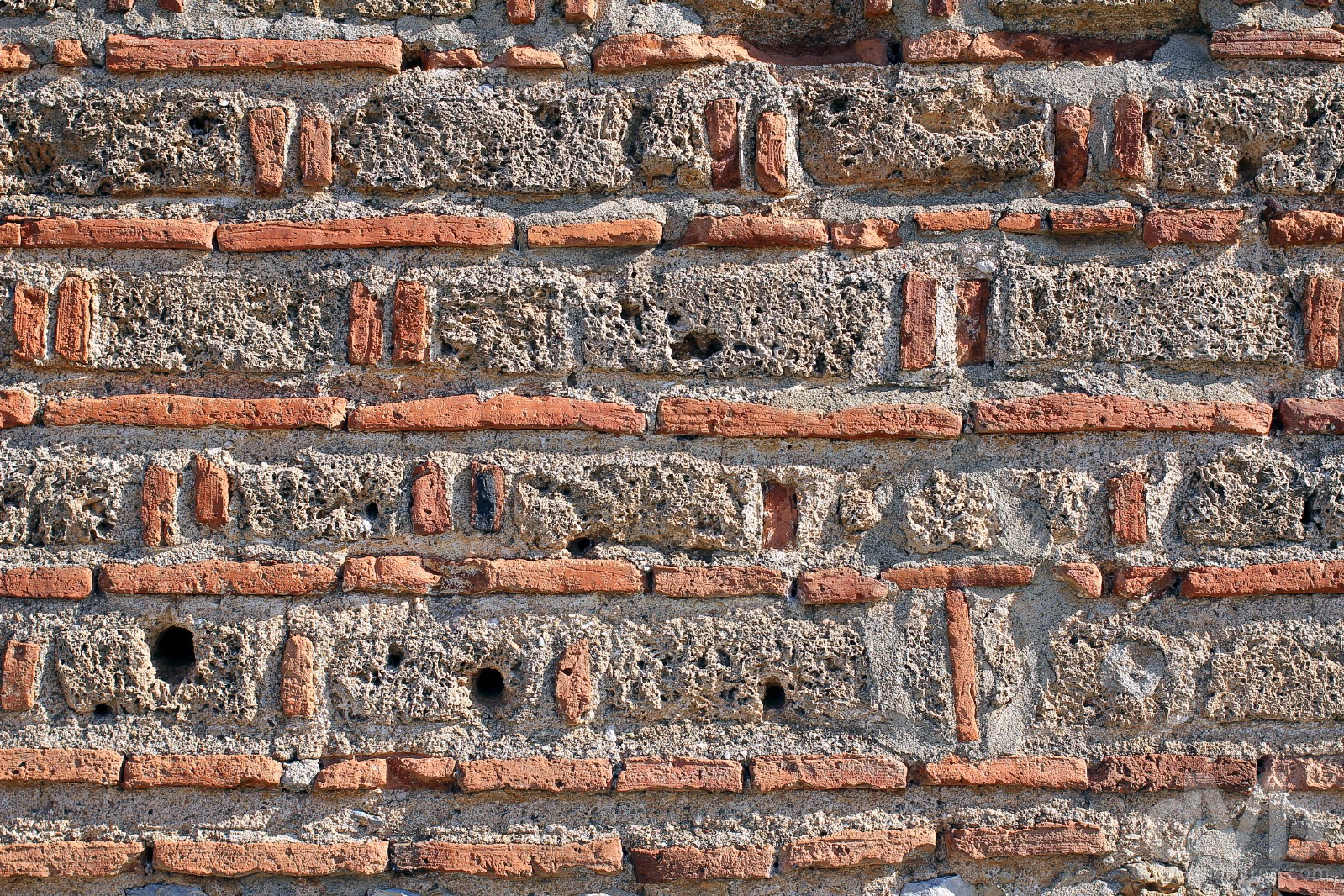
Stonework of the St. Jovan Kaneo Church overlooking Lake Ohrid, southwest Macedonia. April 25, 2017.
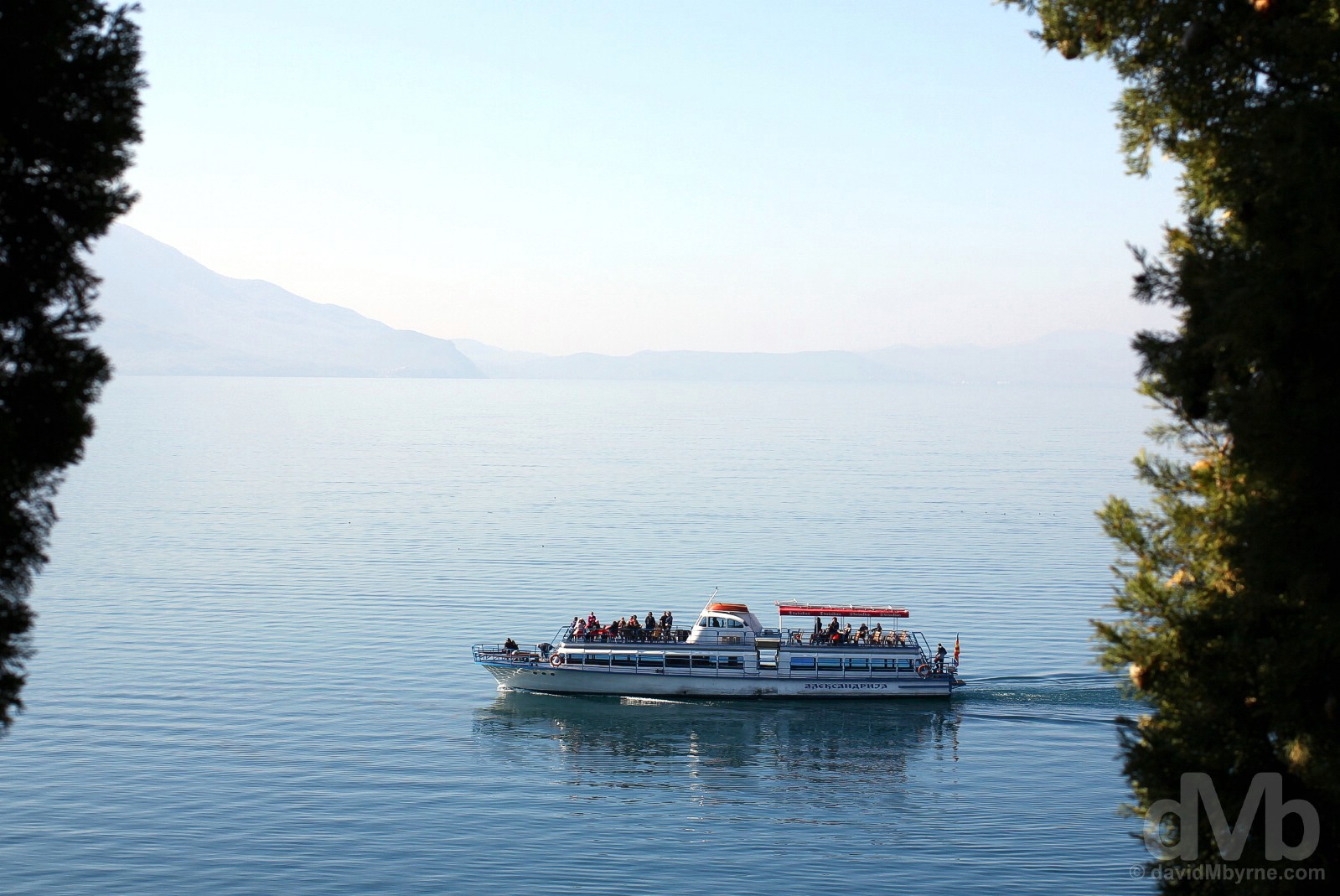
Boating on Lake Ohrid as seen from the grounds of the St. Jovan Kaneo Church, southwest Macedonia. April 25, 2017.
Signing Off | The Complete Ohrid Gallery

